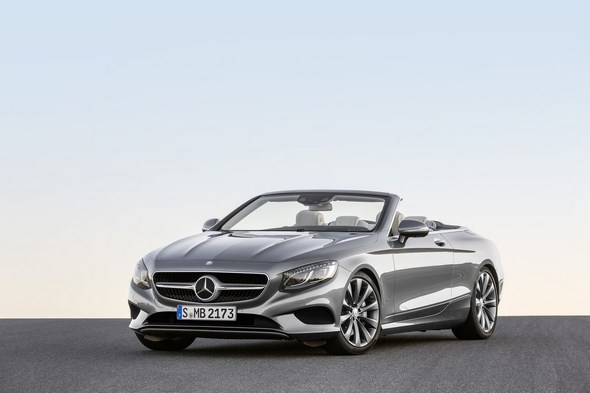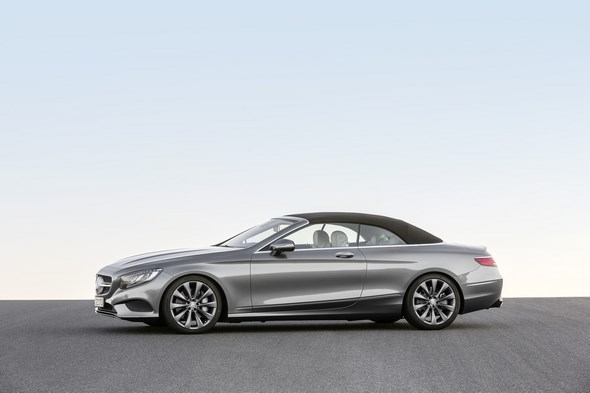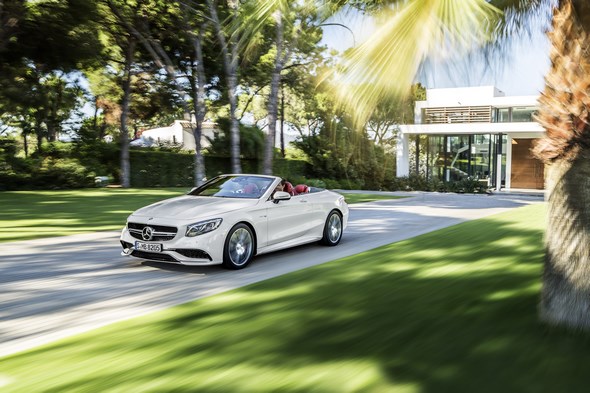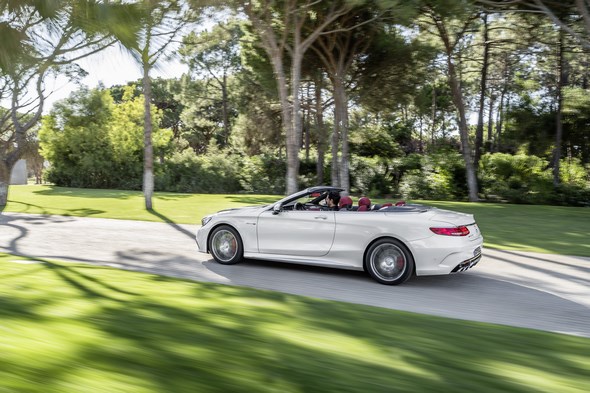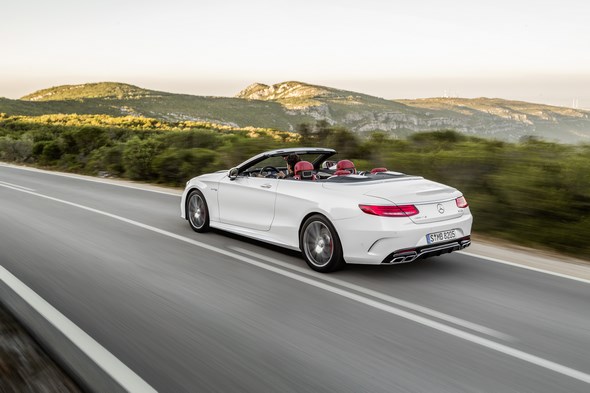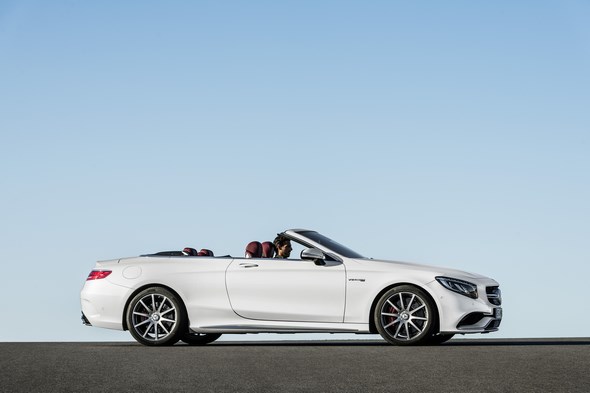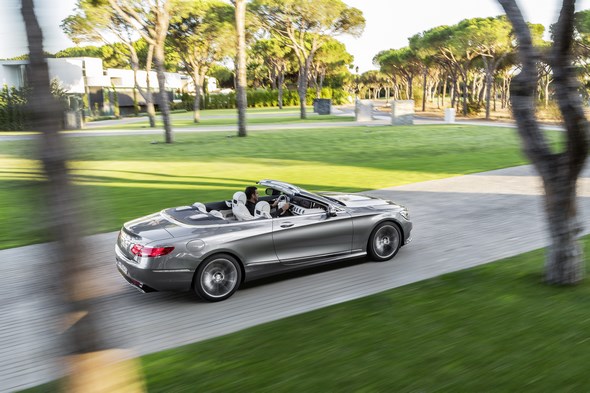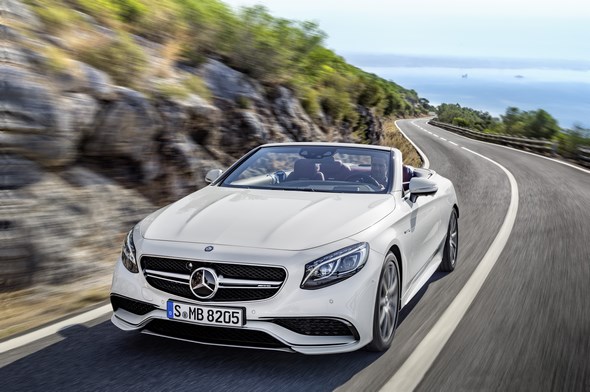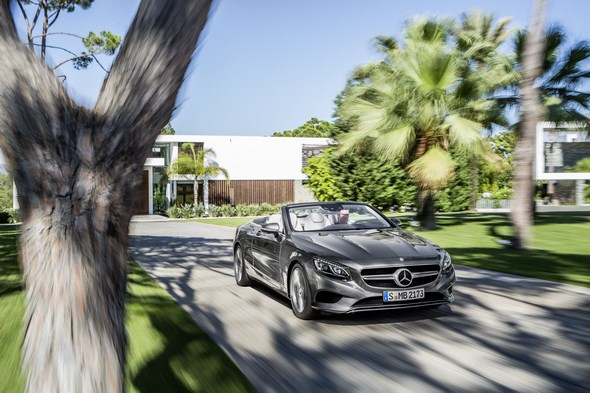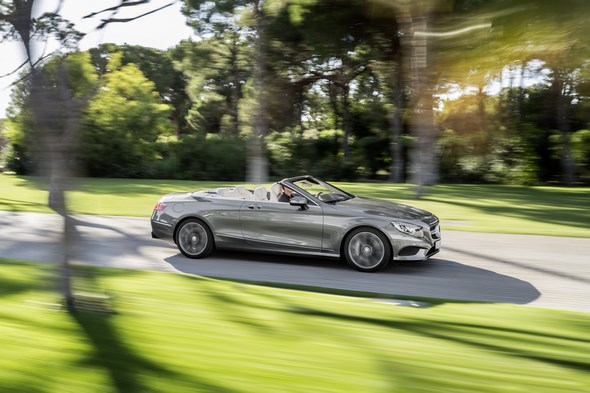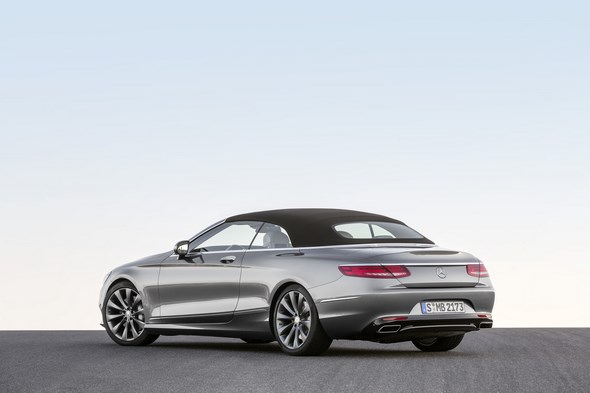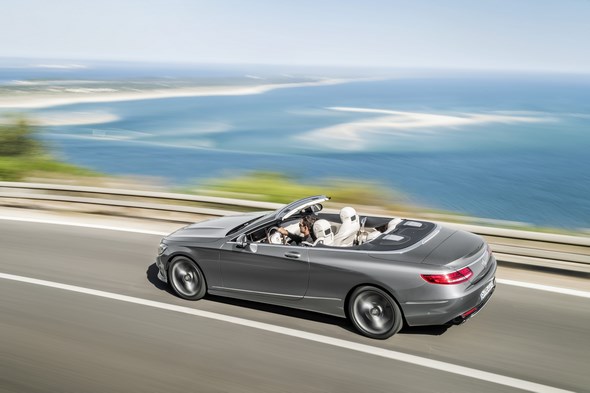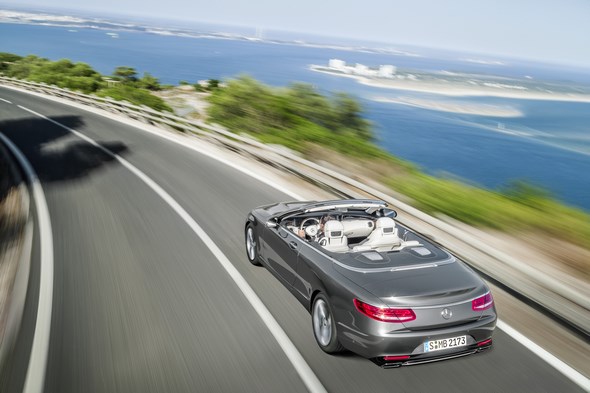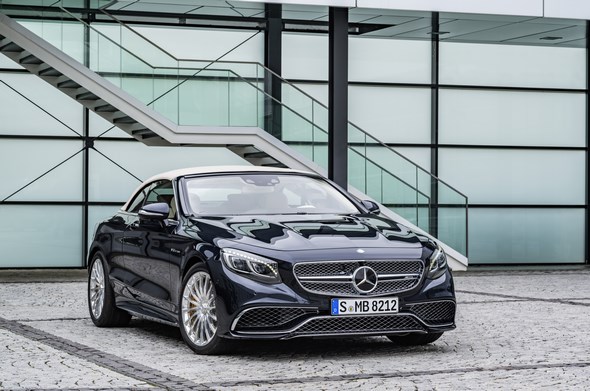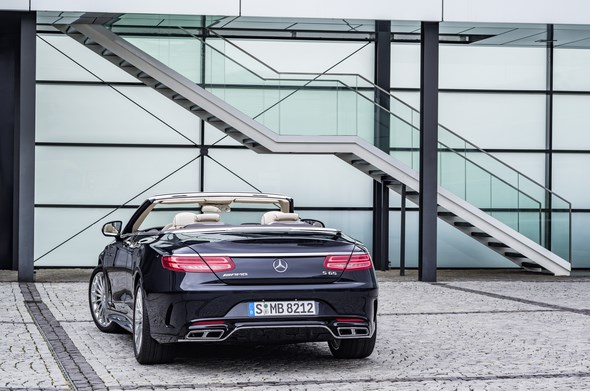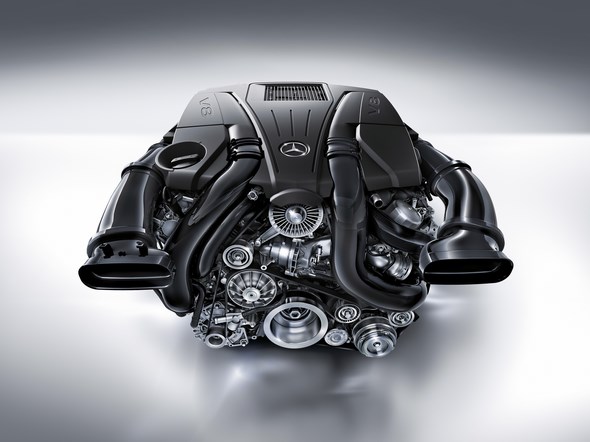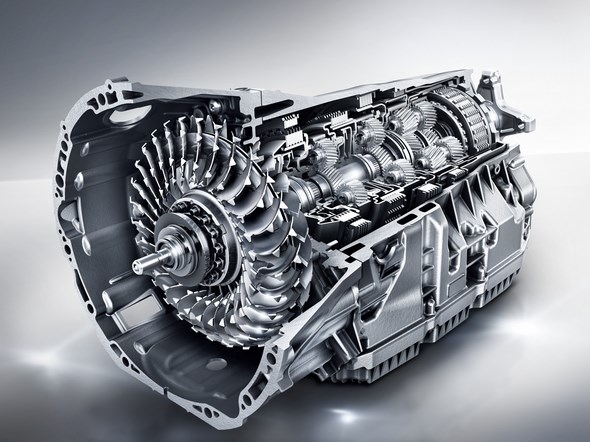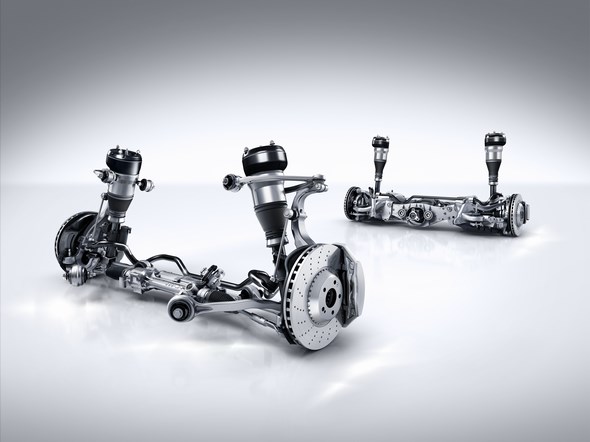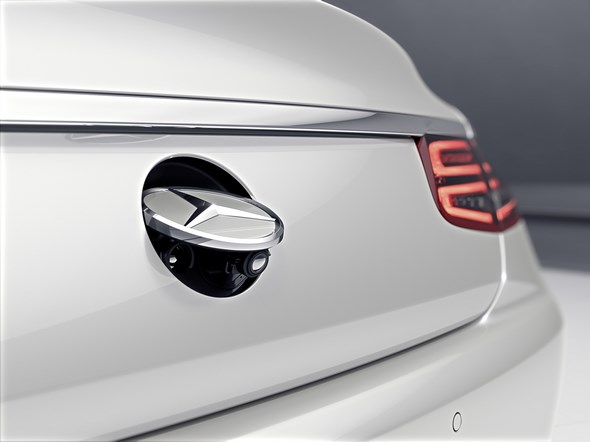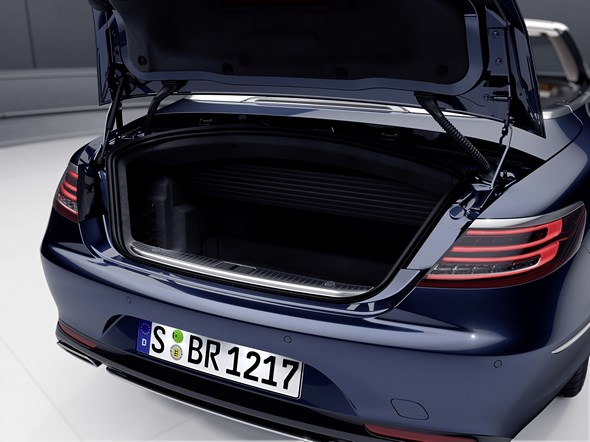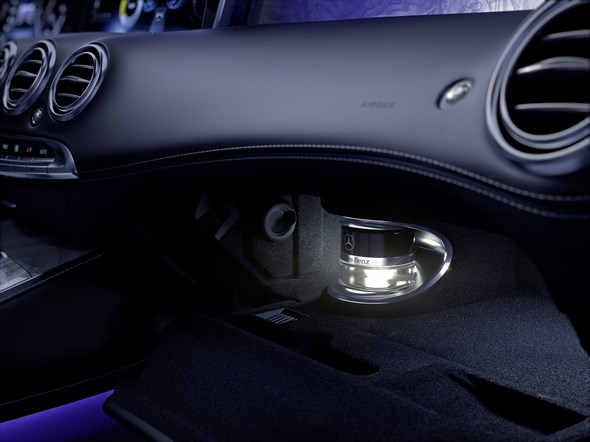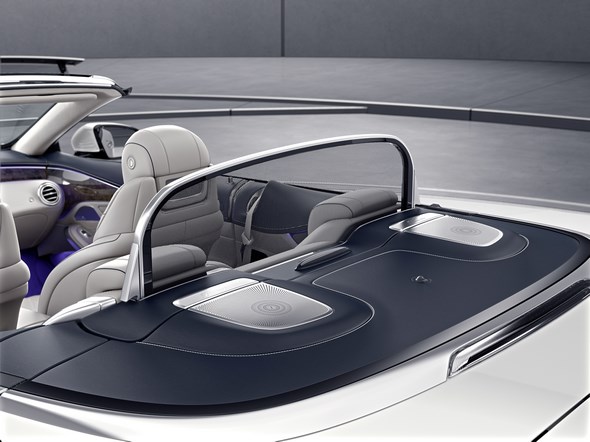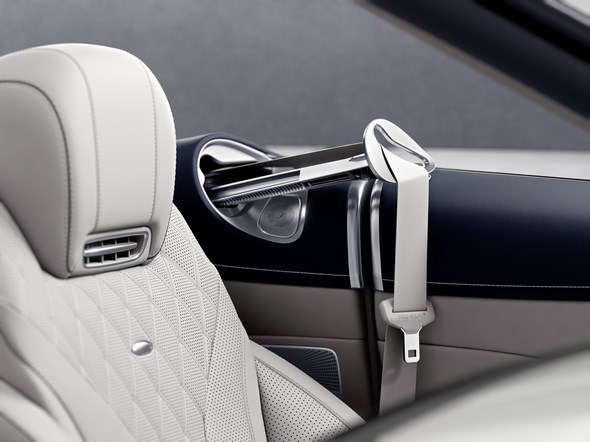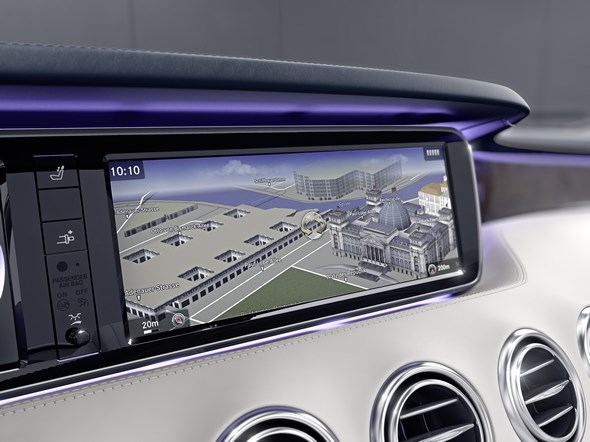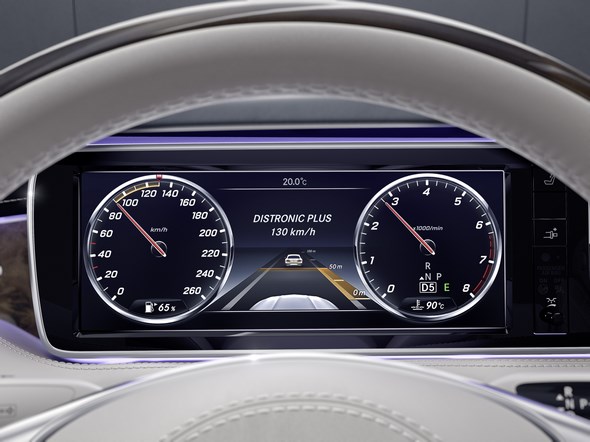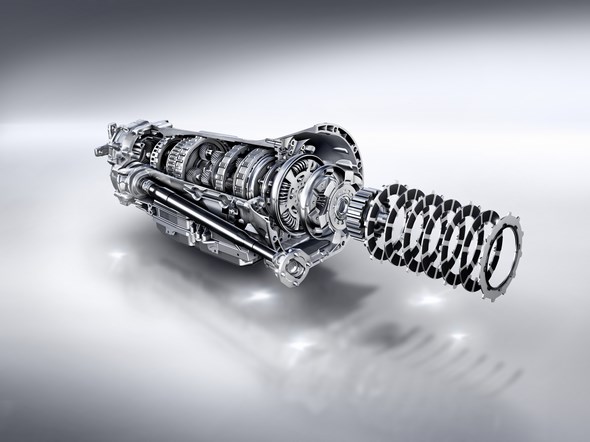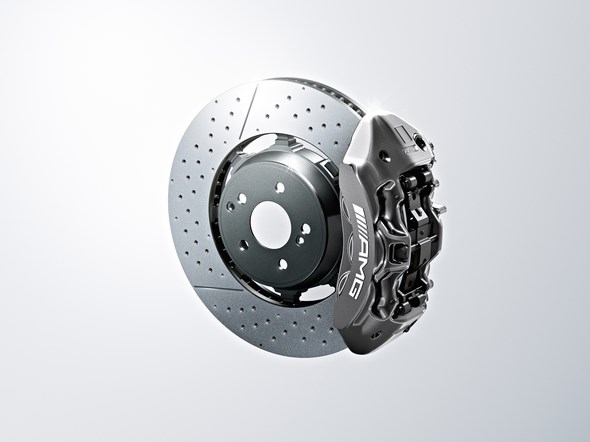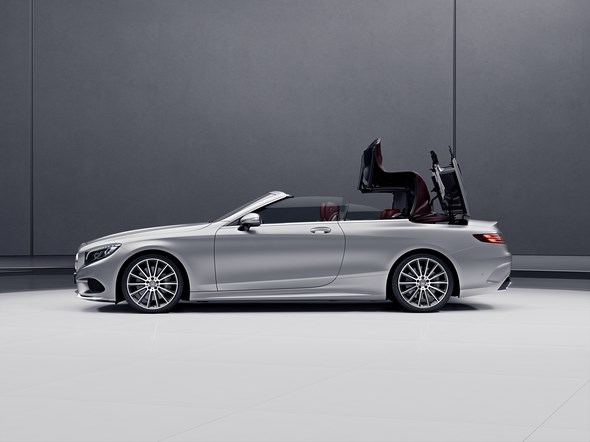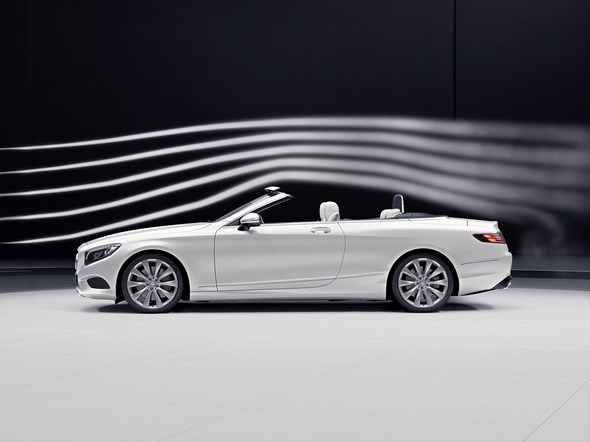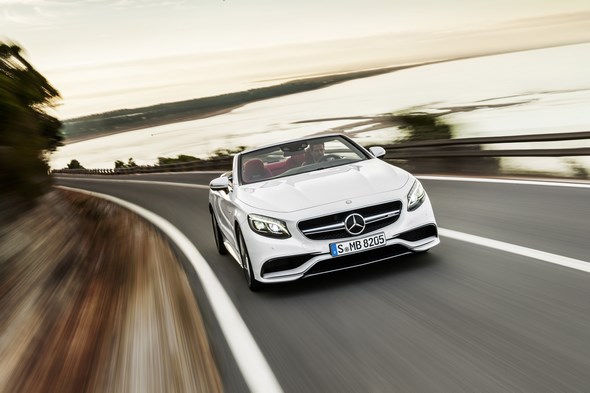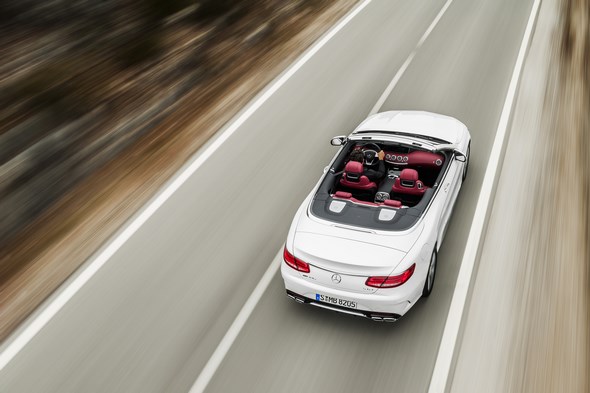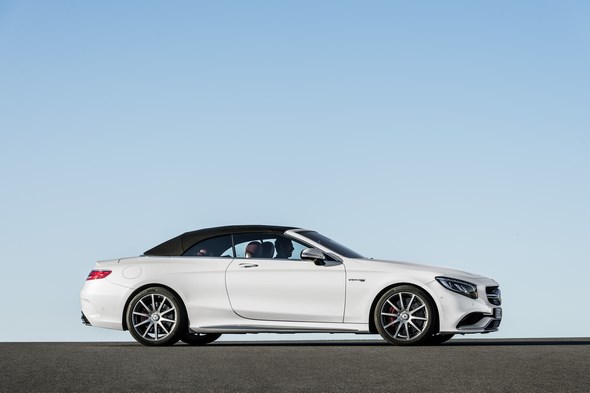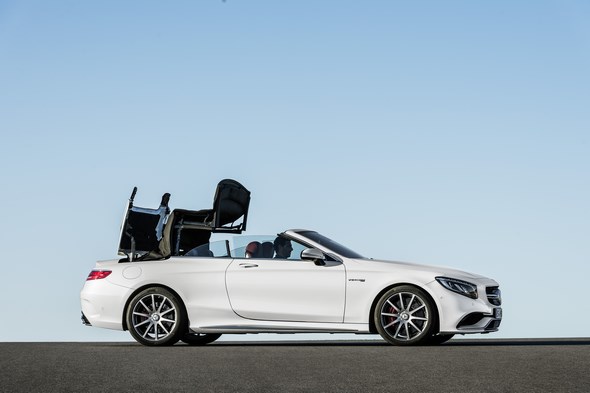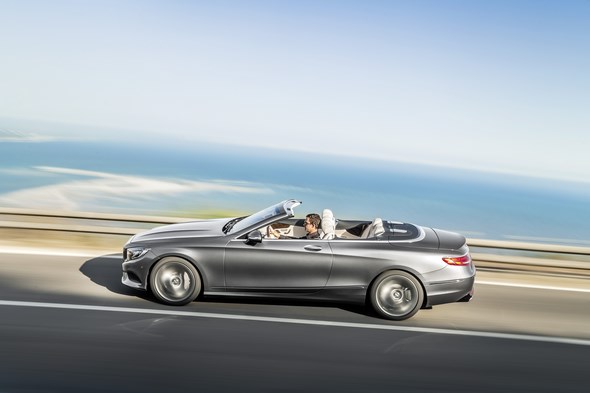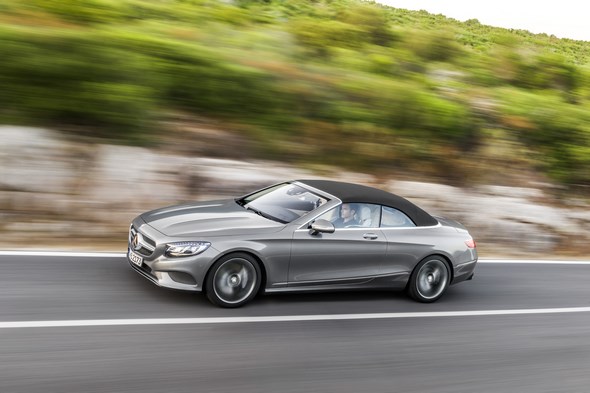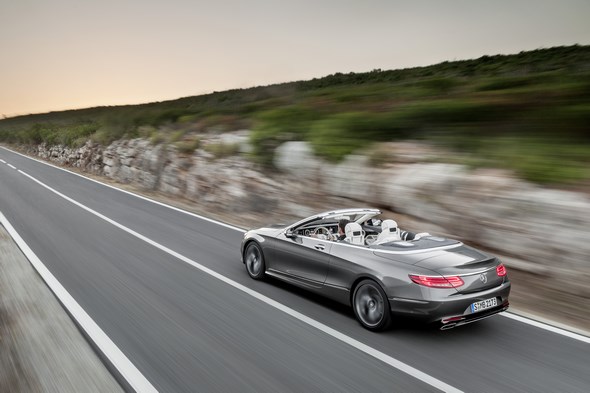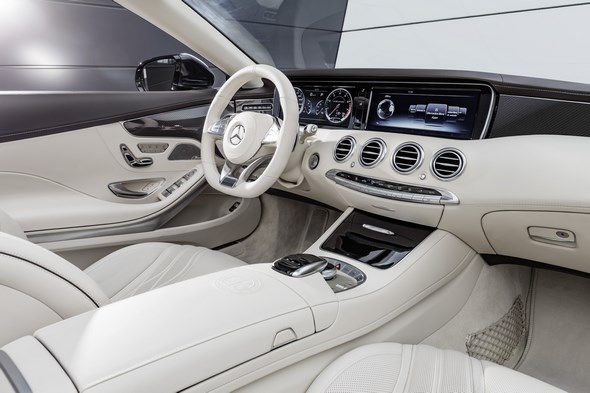The new Mercedes-Benz S-Class Cabriolet

Open-top luxury

The new Cabriolet is the sixth variant of the current S-Class family and the first open-top luxury four-seater from Mercedes-Benz since 1971.
It offers a distinctive, sensual and exclusive design, the cutting-edge technology of the S-Class and a comprehensive warmth and wind protection concept which includes intelligent climate control for cabriolets.
At the same time, Mercedes-AMG is presenting two superlative dream cars in the guise of the S 63 4MATIC and the S 65 Cabriolet.
For Mercedes-Benz, 2016 is the year of the cabriolet and the roadster. No other manufacturer offers so many and such young cabriolets and roadsters as Mercedes-Benz Cars.
The new C-Class Cabriolet – the latest in a long line of dream cars – has just had its world premiere in Geneva, as has the Mercedes-AMG C 43 4MATIC.
Other signs of spring are the two updated SL and SLC roadsters, as well as the performance roadsters from Mercedes-AMG.
The latest range of convertible dream cars extends from the smart fortwo cabrio to the S-Class Cabriolet.
“After 45 years we are once again offering an open-top variant of the S-Class.
The new S-Class Cabriolet symbolises our passion for individual and timelessly exclusive mobility, which we share with our customers,” remarks Ola Källenius, Board Member of Daimler AG, Mercedes-Benz Cars Sales.
Mercedes-Benz lays claim to building the world’s most comfortable convertible. When it comes to climate comfort, the enhanced automatic wind protection system AIRCAP, the AIRSCARF neck-level heating system, the heated armrests, the seat heating also in the rear plus the intelligent climate control ensure that this is indeed the case.
Attention to detail is also evident in the luggage compartment concept: when the soft top is opened, it folds away into a section of the luggage compartment.
The soft top is separated from the remaining luggage compartment space by means of an electrically operated retractable cover which encloses the soft top.
This luggage compartment partition extends automatically when opening the soft top. This means that the driver does not need to stop in order to operate the luggage compartment cover manually, providing for added convenience.
Additional benefits are standard-specification electro-hydraulic remote closing for the boot lid and a through-loading facility into the interior.
“Barely three years after its launch, the S-Class family has grown to six members. We have never offered so many models in the luxury class before – and never before have we enjoyed such success,” says Prof. Dr Thomas Weber, Member of the Daimler Board of Management responsible for Group Research and Mercedes‑Benz Cars Development.
“The S-Class sets the pace on the global market when it comes to safety, efficiency and comfort.”
The V8 engine of the S 500 Cabriolet has an output of 335 kW (455 hp). The displacement stands at 4663 cc and the engine produces peak torque of 700 Nm from 1800 rpm. In NEDC combined mode the Cabriolet gets by on 8.5 litres of premium-grade petrol per 100 km, with CO2 emissions of 199 g/km.
The innovative 9G-TRONIC 9-speed automatic transmission supports both a dynamic and a fuel-saving driving style.
The Mercedes-AMG S63 4MATIC is even more powerful: its 5.5-litre V8 biturbo engine offers an output of 430 kW (585 hp) and peak torque of 900 Nm, AMG Performance 4MATIC all-wheel drive with rear-biased torque split as standard and acceleration from 0 to 100 km/h in 3.9 seconds.
Top of the range is the twelve-cylinder open-top Mercedes-AMG S 65 with an output of 463 kW (630 hp) and peak torque of 1000 Nm.
The data at a glance:
| Mercedes-Benz S 500 | Mercedes-AMG S 63 4MATIC | Mercedes-AMG S 65 | |
| Number of cylinders/arrangement | 8/V | 8/V | 12/V |
| Displacement (cc) | 4663 | 5461 | 5980 |
| Rated output (kW/hp at rpm) | 335 (455) at 5250-5500 | 430 (585) at 5500 | 463 (630) at 4800-5400 |
| Rated torque (Nm at rpm) | 700 at 1800-3500 | 900 at 2250-3750 | 1000 at 2300-4300 |
| NEDC fuel consumption (l/100 km) urban/extra-urban/combined | 11.8/6.8/8.5 | 14.3/8.2/10.4 | 17.1/8.9/12.0 |
| Combined CO2 emissions (g/km) | 199 | 244 | 272 |
| Efficiency class | C | E | F |
| Acceleration 0-100 km/h (s) | 4.6 | 3.9 | 4.1 |
| Top speed (km/h) | 250 | 250 | 250 |
| Price from (euros)1 | 139,051.50 | 187,484.50 | 254,600.50 |
1 Recommended retail price in Germany incl. 19% VAT.
The new S-Class Cabriolet boasts exceptional torsional stiffness. Innovative solutions such as the luggage compartment bulkhead made of aluminium and magnesium as well as the aluminium rear floor also lower the bodyshell weight to the level of the S-Class Coupé.
The standard-fit roll-over protection system behind the rear head restraints features pyrotechnic initiation of the actuators for the first time, in addition to which the roll bars themselves are moved into position by a gas generator.
Design: Dynamic profile, superlative class
“With its clear design idiom, our new S-Class Cabriolet is one of the most beautiful and exclusive S-Class cars of all time,” says Gorden Wagener, Head of Design at Daimler AG. “It embodies modern luxury in a very special way and is an expression of both effortless superiority and progressivity.”
The centrepiece of the front end is the black diamond radiator grille featuring the Mercedes star and a single louvre in silver with chrome inserts.
The bonnet adds dynamic touches with two powerful character lines. The striking front bumper incorporates large air intakes in the middle and at the sides. The chrome trim adds a sporty finishing touch to the front end.
The side design of the S-Class Cabriolet presents a thrilling dynamic coupé-style profile when the soft top is closed. Features of the side design include a low greenhouse, the dropping line of the side wall descending towards the rear and the fully retractable side windows.
The multilayer, taut soft top underscores the vehicle’s class when closed. The soft top is available in black, dark blue, beige and dark red.
The switch in the centre console can be used to open and close the soft top within around 20 seconds while on the move up to a speed of 50 km/h.
The soft top is deposited above the automatically extending luggage compartment partition. With the electronic key, the soft top can also be opened and closed from outside the vehicle.
The soft top compartment lid is framed by a wide chrome trim element. The closed soft top with glass window blends harmoniously into the rear view.
The rear end underscores the impression of width with flat LED tail lights and muscular shoulders. The rear bumper with diffusor-look lower section, two visible tailpipe trims and a horizontal chrome trim element add a sporty finish.
Inside, the S-Class Cabriolet boasts a luxuriously sporty design idiom and fine materials, conjuring up an exceptionally classy interior setting.
The soft top opens up to create an open-air lounge that exudes a yacht-like atmosphere. The carefully matched choice of colours and materials as well as the high-quality controls in real metal or in chrome look underscore the vehicle’s highly exclusive character.
To enable the broadest scope for individualisation, there is a choice of leather, nappa leather or designo Exclusive nappa leather plus six different interior colour concepts, including a maritime-inspired combination of deep-sea blue and porcelain.
The materials feature the highest standard of workmanship and are hand-crafted in character.
Aerodynamics: Exemplary low wind noise
With a Cd value of 0.29, aerodynamics world champion Mercedes-Benz sets a new benchmark in this segment with the S-Class Cabriolet.
The excellent air flow characteristics are attributable, for example, to the underbody panelling concept with extensive engine compartment and main floor panelling, the extensive rear axle cladding, the aerodynamically optimised wheel spoilers, the aerodynamic shape of the exterior mirrors and the well-balanced power split between front and rear axle.
Like its sister model, the S-Class Coupé – the series production car with the quietest interior of all – the open four-seater offers excellent noise-related comfort, too.
A three-layer acoustic soft top comes as standard. Bodyshell measures, the sealing concept for the doors and the double glazing are also crucial to the low wind noise level in the interior.
In addition to noise-related comfort, the aerodynamics engineers have also devoted special attention to maintaining a draught-free interior.
The new S-Class Cabriolet is optionally available with the AIRCAP automatic wind protection system. This can be extended at the touch of a button to reduce turbulence in the interior.
Another optionally available feature is the AIRSCARF neck-level heating. This extends the convertible season by enabling comfortable open-top driving even at low outside temperatures.
With this patented neck-level heating system, warmed air circulates around the head and neck areas of the occupants from the head restraints.
THERMOTRONIC: particularly intelligent climate control
The new S-Class Cabriolet premieres an intelligent climate control system which in future will provide for ideal climate comfort coupled with maximum user-friendliness in all open-top vehicles from Mercedes-Benz.
In contrast to conventional systems, the climate is controlled fully automatically. This means
that the driver does not need to select a mode for closed or open top, nor is it necessary to save a temperature setting for these driving conditions.
An overlapping function performs the considerable feat of achieving an unnoticeable transition between closed and open top (and vice-versa) for maximum climate comfort.
With two climate zones and three climate styles (diffuse, medium or focused), the standard-fit THERMOTRONIC automatic climate control system enables an individual feel-good climate on board.
Driver and front passenger are able to control the temperature, airflow and air distribution and to vary the temperature of their footwells in five levels, independently of each other.
The optionally available Warmth Comfort package provides for even cosier warm conditions. The armrests on the centre console and the doors as well as the multifunction steering wheel can be heated, in addition to the seats.
Chassis and active safety: a fully-fledged member of the S-Class family
The S-Class Cabrio is fitted as standard with the full-support AIRMATIC semi-active air suspension featuring infinitely variable damping control.
This system sets standards with respect to road roar and handling stability. It can be set to a sportier or more comfort-oriented mode, according to personal tastes.
The four-link front axle impresses with a high level of driving comfort, plus precise suspension action.
Like the S-Class Saloon and Coupé, the new Cabriolet is available with numerous new assistance systems that make driving even more comfortable and safer.
Intelligent Drive systems include PRE-SAFE® Brake with pedestrian detection, Distance Pilot DISTRONIC with Steering Pilot and Stop&Go Pilot, Brake Assist BAS PLUS with Cross-Traffic Assist, Active Lane Keeping Assist, Adaptive Highbeam Assist Plus and Night View Assist Plus. Standard-specification COLLISION PREVENTION ASSIST PLUS is able to carry out autonomous braking at speeds of up to 100 km/h, thereby reducing the severity of collisions with slower or stopping vehicles.
The PRE-SAFE® preventive occupant protection system has been upgraded to PRE‑SAFE® PLUS. PRE-SAFE® PLUS can recognise an imminent rear-end collision and warn following traffic by flashing the rear hazard warning lights at a high frequency.
When a danger of collision persists, the system can “lock” the brakes of the stationary vehicle prior to a rear-end collision and activate the PRE-SAFE® belt tensioners immediately before impact.
Intelligent lightweight design: exceptional torsional stiffness, remarkably light
As the sixth variant of the current S-Class, the new S-Class Cabriolet (length/width/height: 5027/1899/1417 mm) is a member of the world’s largest luxury model family.
Its closest relative is the S-Class Coupé, from which the Cabriolet adopts around 60 percent of its bodyshell components. A completely new feature is the rear floor, produced in aluminium for the first time.
This raises the share of this lightweight metal in terms of surface area to over 50 percent in the overall intelligent mix of materials.
In all, the body engineers have achieved two essentially contradictory aims: in terms of torsional stiffness, the S-Class Cabriolet even attains values on a par with those of the S-Class Coupé which was superseded in 2014, while at the same time the bodyshell weight of the current closed sister model has been maintained.
Standard-fit roll over protection system: Fully pyrotechnic
On detecting an impending danger of the vehicle rolling over, the airbag control unit sends a corresponding signal to the roll over protection system.
This is quickly extended behind the rear head restraints, helping to maintain a safe passenger compartment.
The roll bars are extended not by spring force, but – for the first time on a Mercedes-Benz – by pyrotechnical means, using a gas generator.
This is made possible by state-of-the-art yaw rate sensors which, in contrast to the previously employed tilting cone sensors, virtually rule out incorrect actuation.
The Mercedes-Benz management team on the new S-Class Cabriolet
“A new addition to the S-Class family”
“Barely three years after its launch, the S-Class family has now grown to six members. Never before have we offered so many models in the luxury class, and never before have we been so successful. “The S-Class sets the pace on the global market when it comes to safety, efficiency and comfort.”
Prof. Dr Thomas Weber, Member of the Board of Management of Daimler AG,
Group Research and Mercedes-Benz Cars Development
“After 45 years we can again offer friends of the Mercedes-Benz brand an open variant of the S-Class. The new S-Class Cabriolet symbolises our passion for individual and timelessly exclusive mobility, which we share with our customers.”
Ola Källenius, Member of the Board of Management of Daimler AG, Mercedes‑Benz Cars Sales & Marketing
“With its clear design idiom, our new S-Class Cabriolet is one of the most beautiful and exclusive S-Class models ever. It embodies modern luxury in a very special way and is an expression of both effortless superiority and progressivity.”
Gorden Wagener, Head of Design at Daimler AG
“The S 63 and S 65 Cabriolet are further fascinating AMG dream cars from Affalterbach. They demonstrate in impressive style that we are keeping our foot firmly on the gas in 2016. We are continuing our model initiative with a vengeance – in all market segments.”
Tobias Moers, Chairman of the Board of Management of Mercedes-AMG GmbH
Design: Dynamic profile, superlative class
Perhaps the most beautiful S-Class of all time
On the basis of the S-Class Coupé, the Cabriolet has been developed as an uncompromising open-top dream car in accordance with a vision which was on the design agenda from the outset.
“With its clear design idiom, our new S-Class Cabriolet is one of the most beautiful and exclusive S-Class cars of all time,” says Gorden Wagener, Head of Design at Daimler AG.
“It embodies modern luxury in a very special way and is an expression of both effortless superiority and progressivity.”
The centrepiece of the front end is the black diamond radiator grille featuring the Mercedes star and a single louvre in silver with chrome inserts.
The bonnet adds dynamic touches with two powerful character lines. The striking front bumper incorporates large air intakes in the middle and at the sides.
The chrome trim adds a sporty finishing touch to the front end. The optional LED Intelligent Light System showcases the car’s elegance in glittering style with exquisite Swarovski crystals for the direction indicators and daytime running lamps.
The side design of the S-Class Cabriolet presents a thrilling dynamic coupé-style profile when the soft top is closed.
Features of the side design include a low greenhouse, the dropping line of the side wall descending towards the rear and the fully retractable side windows.
The multilayer, taut soft top underscores the vehicle’s class when closed. The soft top is available in black, dark blue, beige and dark red.
The newly developed soft top from Mercedes-Benz is a tensioning-arm top. For closing purposes, the required closing forces are generated by moving the tensioning arms beyond the dead centre position – a process known as ‘overcentring’.
This avoids the need for any additional closures on the soft top compartment lid, in keeping with the high design quality embodied by the S-Class Cabriolet.
The rear end underscores the impression of width with flat LED tail lights and muscular shoulders. The closed soft top with glass window blends harmoniously into the rear view.
The soft top compartment lid is framed by a wide chrome trim element. The rear bumper with diffusor-look lower section, two visible tailpipe trims and a horizontal chrome trim element add a sporty finish.
The Mercedes star in the boot lid is hinged and performs several functions: it serves as a handle for manual opening and is also the cover for the reversing camera and the 360° camera (optional).
The interior of the S-Class Cabriolet is characterised by a sporty and luxurious design idiom, fine materials and supreme high-class appeal.
The soft top opens up to create an open-air lounge that exudes a yacht-like atmosphere. The carefully matched choice of colours and materials and the high-quality controls in real metal or in chrome look underscore the vehicle’s highly exclusive character.
There is a fluid transition between the doors and the rear side panelling, emphasising the elegance of the interior.
To enable the broadest scope for individualisation, there is a choice of leather, nappa leather or designo Exclusive nappa leather plus six different interior colour concepts, including a maritime-inspired combination of deep-sea blue and porcelain.
The materials feature the highest standard of workmanship and are hand-crafted in character. The standard-fit ambient lighting offers a choice of seven light moods.
The upper anchorage point of the front seat belts is integrated into the rear side panelling without disrupting the waistline when the windows are open.
The belt feeders make it easy for the passengers to reach the belts.
Comfort: a wealth of exceptional amenities
Exclusive first-class lounge
The S-Class Cabriolet comes with an extensive range of standard equipment – among others COMAND Online, intelligent THERMOTRONIC automatic climate control, electrically adjustable front seats with Memory Package, as well as the LED Intelligent Light System all come as standard.
The two-door model can be individualised by adding the AMG design and equipment line, the Exclusive Package, and numerous other optional extras.
The extraordinary attention to detail in the flagship S-Class Cabriolet is immediately apparent before even getting into the car.
Standard features include power-closing doors and boot lid, remote boot lid release and closing, and the KEYLESS-GO start function.
With the electronic key, the soft top can also be opened and closed from outside the vehicle.
The switch in the centre console can be used to open and close the soft top within around 20 seconds while on the move up to a speed of 50 km/h.
The soft top is deposited above the automatically extending luggage compartment partition.
Standard equipment for the front seats includes the Memory package and an EASY-ENTRY function for the rear passengers, which allows the original seat position to be recorded and saved contactlessly by means of a Hall sensor.
After the driver’s seat backrest has been folded back and locked automatically, the seat returns to its original position automatically.
If space gets too tight for a rear passenger when the front seat is moved backwards, this will be detected by the control unit. The seat then moves forward again by approximately 50 mm and remains in this position.
Sophisticated: automatic boot separator
A loving attention to detail is also evident in the luggage compartment concept: when the soft top is opened, it folds away into a section of the luggage compartment.
The soft top is separated from the remaining luggage compartment space by means of an electrically operated retractable cover which encloses the soft top.
This luggage compartment partition extends automatically when opening the soft top. This means that the driver does not need to stop in order to operate the luggage compartment cover manually, providing for added convenience.
The partition is not activated if the luggage compartment has been so loaded in such a way that there are objects in the area of the partition.
When the soft top is closed, the luggage compartment partition can be retracted by pressing a button in the inner panelling of the boot lid, so as to increase the available luggage space.
In addition, there is a through-loading facility into the interior.
The optional KEYLESS-GO access and drive authorisation system offers handle recess illumination and HANDS-FREE ACCESS for the luggage compartment: the driver merely has to briefly hold his or her foot under the rear bumper to open or close the lid.
The luggage compartment has a capacity of 350 litres when the soft top is closed.
The completely new electromechanical closing system which has been developed for the Coupé also features on the Cabriolet for improved operating convenience and reduced noise. Its advantages are:
- Reduction in the force needed to operate the door handle as well as a pleasant touch and feel
- High-quality feedback noise
- Quiet central locking
- Almost silent power-closing of the doors and boot lid.
It’s got the looks: exclusive extras and equipment lines
Optionally available expressive headlamps, each featuring 47 Swarovski crystals, lend the new S-Class Cabriolet a uniquely striking appearance.
17 angular crystals form the flare-shaped daytime running lamps, with 30 round-shaped crystals making up the turn indicator lamps.
Exterior components of the AMG Line include AMG bodystyling components, consisting of front and rear apron plus side sill panels with inserts painted in the body colour, the diamond radiator grille with pins in chrome, and AMG 19-inch 5‑twin-spoke light-alloy wheels painted titanium grey with a high-sheen finish.
The front and rear brake discs are perforated, while the front and rear brake callipers have “Mercedes-Benz” lettering.
Interior features of the AMG Line include high-gloss black poplar wood trim, AMG sports pedals in brushed stainless steel with rubber studs and AMG floor mats in velour.
The Exclusive Package includes the exclusive designo nappa leather upholstery, consisting of seats and instrument panel in nappa leather with contrasting topstitching and edging, centre armrest and door centre panels as well as front and back arm rests in nappa leather with contrasting topstitching.
Another stand-out feature is the seat upholstery layout in a diamond design with patterned perforations.
There are metal designo badges in the seat backrests plus a designo roof liner and sunblinds in DINAMICA microfibre.
Also part of the Exclusive Package are the map pockets in the driver and front passenger seat backrest in designo nappa leather, velour floor mats with designo metal badges, stainless steel boot sill as well as door sills with illuminated “Mercedes-Benz” lettering.
Climate comfort: a host of innovations
Numerous innovations enhance seating and climatic comfort. These include the newly developed Thermotronic for Cabriolets (details in the following section).
In contrast to conventional systems, the climate is controlled fully automatically. This means that the driver does not need to select a mode for closed or open top, nor is it necessary to save a temperature setting for these driving conditions.
An overlapping function performs the considerable feat of achieving an unnoticeable transition between closed and open top (and vice-versa) for maximum climate comfort.
The new S-Class Cabriolet is optionally available with the AIRCAP automatic wind protection system.
This can be extended at the touch of a button to reduce turbulence in the interior. AIRCAP consists of two components: a wind deflector with a grid in the windscreen frame that is extendible by seven centimetres and an extendible draught-stop behind the rear seats with convex contours and stainless steel trim elements.
Another optionally available feature is the AIRSCARF neck-level heating. This extends the convertible season by enabling comfortable open-top driving even at low outside temperatures.
With this patented neck-level heating system, warmed air circulates around the head and neck areas of the occupants from the head restraints.
The optionally available Warmth Comfort package provides for even cosier warm conditions. The armrests on the centre console and the doors as well as the multifunction steering wheel can be heated in addition to the seats.
Driver and front passenger can choose between three different heating levels at the touch of a button.
The “Seat Comfort package for driver and front passenger” incorporates the ENERGIZING massage function based on the hot-stone principle. Working together with physiotherapists and psychologists, the seat specialists at Mercedes-Benz have developed a unique massage function with 14 separately actuated air cushions in the backrest, as well as an integrated warming function.
There is a choice of six massage programs, two of them using the warming function. The package also includes fast-acting seat heating Plus and active multicontour seats at the front, whose lateral support is adjusted to the given driving situation by pneumatic means.
The package can be augmented with climatised seats for driver and front passenger. This option includes active seat ventilation with so-called reversing fans.
These allow the direction of the fan rotation and thus of the airflow through the seat structure to be reversed.
At the start of the ventilation process, cooler ambient air can thus be drawn into the seat cushions. This can make the process of cooling the surface temperature of an overheated seat much faster than in previous active cooling systems.
After four minutes the fans are automatically switched to blower mode to reduce draughts, so ensuring occupant comfort over the longer term.
Together with perforated leather, four fans in the seat cushion and two in the backrest ensure an even and relative air humidity at the contact area between occupant and seat.
The intensity can be adjusted to individual needs in three stages. Seat heating in the rear is also available.
The AIR-BALANCE package comprises the fragrancing and ionisation components and even more effective filtration than in the standard vehicle.
The fragrancing can be switched on and off manually, and the intensity can be adjusted. The interior smell of the S-Class is individualised by the fragrancing system – with five different fragrances to choose from.
PACIFIC MOOD is a new fragrance which is exclusively available as standard for the Cabriolet. The smell of the interior is not permanently changed as a result of fragrancing, nor are the fragrance molecules deposited on the vehicle’s fabric surfaces or on clothing.
The fragrance is discreet and mild, and dissipates rapidly.
The new Mercedes-Benz S-Class Cabriolet has been awarded the Seal of Quality of the European Centre for Allergy Research Foundation (ECARF).
The ECARF Seal of Quality is used by ECARF to designate products that have been scientifically tested and proven to be suitable for allergy sufferers.
Alongside comprehensive testing for inhaled and contact allergens, Mercedes-Benz has been testing the interior emissions of all its model series for 23 years now.
Good vision in rain is ensured by MAGIC VISION CONTROL. The system cleans the windscreen without the splash of water that usually briefly impairs the driver’s field of view in the case of conventional windscreen washing systems.
With MAGIC VISION CONTROL, the fluid is supplied to the windscreen by means of water guides integrated on both sides along the wiper blade and minute spraying holes. MAGIC VISION CONTROL operates based on the vehicle speed and takes account of the outside temperature.
The soft top status is also scanned and during open-top driving the quantity of water is further reduced in the interests of maximum comfort for the customer.
Plus the contact surface of the wiper blades on the windscreen is electrically heated as standard to prevent the wiper blades from getting stuck in snow.
Under the microscope: new automatic climate control for Cabriolets
Particularly intelligent climate control
The new S-Class Cabriolet premieres an intelligent climate control system which in future will provide for ideal climate comfort coupled with maximum user-friendliness in all open-top vehicles from Mercedes-Benz.
The air conditioning experts at Mercedes-Benz developed a new software architecture specifically for this system, which underwent rigorous testing on state-of-the-art “hardware-in-the-loop” test stands prior to fine-tuning in the climate tunnel and on test drives.
In contrast to conventional systems, THERMOTRONIC climate control operates fully automatically. This means that the driver does not need to select a mode for closed or open top, nor is it necessary to save a temperature setting for these driving conditions.
An overlapping function performs the considerable feat of achieving an unnoticeable transition between closed and open top (and vice-versa) for maximum climate comfort.
The Cabrio benefits here from the sophisticated climate control concept for the S-Class, which enables automatic individual control of each nozzle, for example.
The air conditioning control unit is fully networked and communicates with many vehicle components. In all, 12 sensors and 18 actuators provide for an ideal climate in all conditions.
In addition to interior and exterior temperature, the sensors also detect the level of solar radiation. A sensor for air quality constantly monitors the quality of the outside air being drawn in.
To effectively prevent the windows from fogging up, a dewpoint sensor measures the absolute humidity on the front windscreen.
Two solar sensors on the dashboard and on the rear shelf ensure that blower level and temperature are adjusted to the selected settings in good time in response to any changes in solar irradiation.
With two climate zones and three climate styles (diffuse, medium or focused), the standard-fit THERMOTRONIC automatic climate control system enables an individual feel-good climate on board.
Driver and front passenger are able to control the temperature, airflow and air distribution and to vary the temperature of their footwells in five levels, independently of each other.
The status of the soft top influences air distribution, blower operation and temperature control. The new THERMOTRONIC with intelligent climate control follows the Mercedes-Benz philosophy of supplying cold air quickly after starting up the vehicle and subsequently controlling the climate as inconspicuously as possible.
Body: exceptional torsional stiffness, remarkably light
Intelligent lightweight construction
As the sixth variant of the current S-Class, the new S-Class Cabriolet (length/width/height: 5027/1899/1417 mm) is a member of the world’s largest luxury model family.
Its closest relative is the S-Class Coupé, from which the Cabriolet adopts around 60 percent of its bodyshell components.
A completely new feature is the rear floor, produced in aluminium for the first time. This raises the share of this lightweight metal in terms of surface area to over 50 percent in the overall intelligent mix of materials.
Striking new components are the longitudinal members in die-cast aluminium, based on a technology which was developed for the current SL.
With the aid of a sand core, the longitudinal member is produced as a closed cast body which is hollow inside.
This enables various components to be integrated in the longitudinal member, while also making varying wall thicknesses possible.
This means a functionally ideal and weight-optimised design for the longitudinal member. In order to attain the high functional objectives (noise, vibration, durability and crash characteristics), the multifunction well (previously: spare wheel well) is welded in place in the bodyshell.
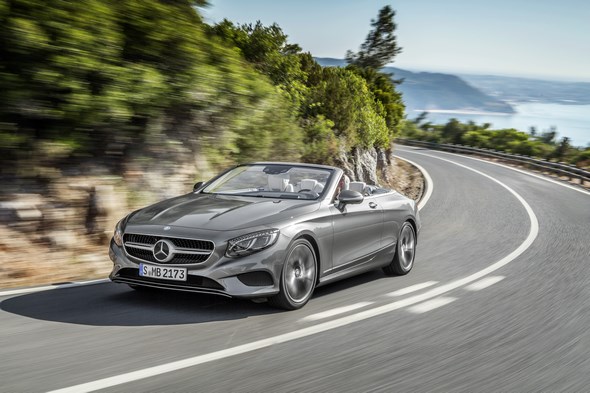
Another new feature is the rear wall behind the rear seats, which serves to reinforce the body while at the same time supporting the pyrotechnically extending roll bars and also incorporating a through-loading opening into the luggage compartment.
This rear wall consists of aluminium sections, the characteristic shape of which has earned this component the internal nickname “hockey goal”.
Two shear panels, in the form of the magnesium rear wall and a cover consisting of aluminium sections, assure this assembly of high rigidity.
The rear wall is attached via two additional large cast aluminium parts to the side wall. There are also numerous reinforcements on the underfloor to enhance the four-seater convertible’s rigidity.
Aluminium in the form of cast, extrusion-press and sheet-metal components is the material of choice for the front section, the rear end, the doors and large parts of the outer skin.
The engines, transmissions and most of the chassis components are also made of aluminium. The safety occupant cell consists of high-strength and ultra-high-strength steels, especially for the load paths.
All components were configured based on the stringent specifications book requirements regarding crash resistance, durability and NVH (Noise, Vibration and Harshness).
Noise-insulating and noise-absorbing elements made of various foam or fibre materials are used on the entire body to reduce noise levels in the passenger compartment.
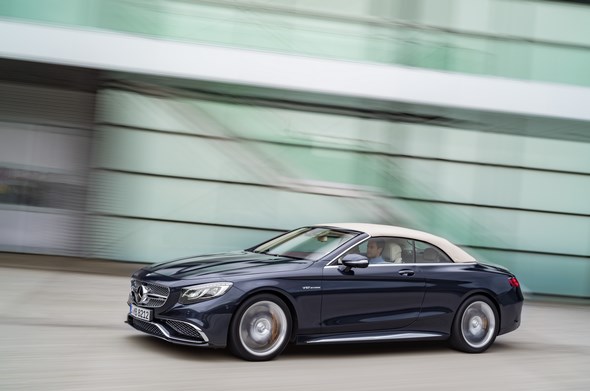
Doors: large and innovative
A great deal of thought went into designing and producing the doors for the Cabriolet, as they are extremely long (1.4 metres) and have no window frames.
The door shell consists entirely of aluminium components joined by means of laser welding, solid punch rivets and bonding.
High-strength aluminium sections are used on the inside of the doors, both as side impact protection and on the inner beltline to ensure the highest possible level of side crash or frontal offset crash resistance.
A new process is applied to produce the inner door section with its considerable depth and length. In the “heat-assisted forming” process, the inner door section is induction-heated to over 300°C within a few seconds after the first deep-drawing stage.
Consequently, the complex component geometry can be produced in the finished dimensions in the following second deep-drawing stage.
The second innovative production process is the “new laser-joined door folding concept” (NLT). Unlike conventional folding, in which the outer door panel is folded onto the inner door section and fixed by means of adhesive, the panelling is folded empty, braced on the inner door section and joined by means of laser fillet weld in this case.
There is therefore no need for any adhesive whatsoever, and an aired, waxed fold offers optimum corrosion resistance.
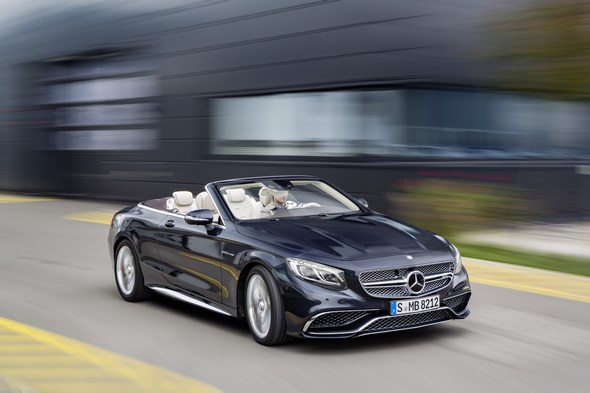
Front section: aluminium for well-balanced weight distribution
The structure of the Cabriolet’s front section corresponds to that of the S-Class Saloon and the Coupé. The front section is one of the preferred lightweight-construction zones for achieving balanced weight distribution of the entire vehicle.
As well as being lighter than its steel counterpart, the aluminium front section also greatly enhances crash and NVH performance.
Cast aluminium and extruded aluminium sections are used in addition to sheet aluminium. Die-cast aluminium was chosen for the shock absorber strut bracket because of its good integration properties.
In this way it was possible to connect the front module without additional holders, for example. As well as reducing the number of components, die-casting also enables the component to be designed to withstand specific loads and stresses.
Morphological analyses were conducted to configure the wall thicknesses and geometry of the component so as to meet the strict functional requirements accurately.
In addition to local optimisation of the introduction rigidity at the shock absorber strut bracket and at the integral carrier, a cross-functional load path was conceived to further improve the system as a whole.
The aluminium struts running in X-direction from the shock absorber strut bracket to the crossmember on the firewall provide support in the event of a crash.
Supplemented by a multipiece framework, these struts also help to suppress the Y-movement of the side members.
This design allowed the new load path to be incorporated into the limited installation space in the front section. The forces are applied to the bodyshell structure in the three-piece cowl, which has been configured as a cast aluminium component in the centre section.
In this case too, the casting allows a functionally perfect connection with distinct advantages in terms of weight and installation space.
The side members have been designed as combined aluminium extruded sections/castings to optimise crash performance, rigidity and component integration.
The protrusions of the extruded aluminium sections of the side members required for packaging reasons have been designed to also have a positive effect on folding behaviour in the event of a crash.
The cavity closed by a foam piece is also used as a resonance space for the Frontbass system. The side members are connected to the steel passenger cell by means of cast aluminium components that allow a very rigid connection and integration of the integral carrier mounting.
Passenger cell: steel for safety
The safety passenger cell consists primarily of steel. The use of higher grades of steel enables substantially higher crash standards and higher NVH requirements to be met.
In the area of the B-pillar, roof frame and tunnel reinforcement, thermoformed ultra-high-strength steels are used, for example.
These take the form of weight-optimised, tailored products with different steel thicknesses. In the lower side member area, an ultra-high-strength steel is used as a roll-profiled component.
In all, the body engineers have achieved two essentially contradictory aims: in terms of torsional stiffness, the S-Class Cabriolet even attains values on a par with those of the S-Class Coupé which was superseded the year before last, while at the same time the bodyshell weight of the current closed sister model has been maintained.
The weight-saving measures also include ingenious solutions such as the vibration absorber which the hydraulic pump of the automatic soft top uses as additional weight, thereby saving around 7 kg.
Aerodynamics: exemplary in terms of wind noise, too
Quiet and efficient
Mercedes-Benz lays claim to building the world’s most comfortable convertible. Contributory factors here include low wind noise and little turbulence in the interior.
The AIRCAP automatic wind protection system has undergone further development.
With a Cd value of 0.29, aerodynamics world champion Mercedes-Benz sets a new benchmark in this segment with the S-Class Cabriolet.
The excellent air flow characteristics are attributable, for example, to the underbody panelling concept with extensive engine compartment and main floor panelling, the extensive rear axle cladding, the aerodynamically optimised wheel spoilers, the aerodynamic shape of the exterior mirrors and the well-balanced power split between front and rear axle.
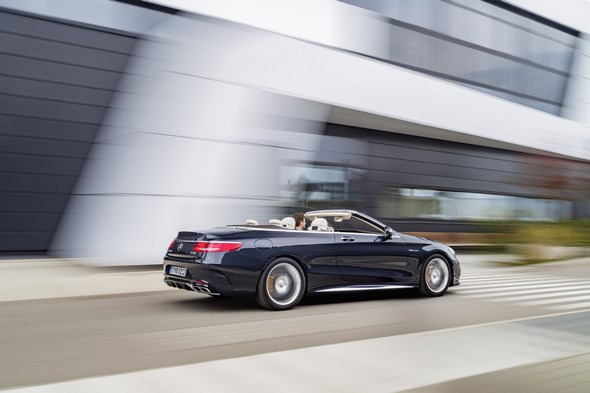
Less draught: AIRCAP curbs turbulence
In addition to noise-related comfort, the aerodynamics engineers have also devoted special attention to maintaining a draught-free interior.
The new S-Class Cabriolet is optionally available with the AIRCAP automatic wind protection system. This can be extended at the touch of a button to reduce turbulence in the interior.
AIRCAP consists of two components: a wind deflector with a grid in the windscreen frame that is extendible by seven centimetres and an extendible draught-stop behind the rear seats with convex contours and stainless steel trim elements.
The innovative diffusor ribs on the bottom edge of the front louvre are a further development. They produce specific turbulence effects to reduce the noise level.
The wind deflector is finished in the body colour on the S-Class Cabriolet.
Keeping things quiet: three-layer acoustic soft top
As the sister model of the S-Class Coupé – the series production car with the quietest interior of all – the open four-seater offers excellent noise-related comfort, too.
A three-layer acoustic soft top comes as standard. The outer fabric cover incorporates a butyl layer as a water barrier on the inside, as opposed to the commonly used material neoprene.
This lowers noise levels, as do the enhanced upholstery matting and the acoustically optimised roof lining.
The insulating layer also ensures that the elegant profile silhouette is not spoiled by bows that are visible from the outside.
Bodyshell measures, the sealing concept for the doors and the double glazing are also crucial to the low wind noise level in the interior.
Active safety: Intelligent Drive
Assistance in all driving situations
With the Driving Assistance package Plus (option), the driver can relax even while driving in stop-and-go traffic, as DISTRONIC PLUS with Steering Assist and Stop&Go Pilot attends to keeping the car a safe distance behind the vehicle in front and in the centre of the lane.
Like the S-Class Saloon and Coupé, the new Cabriolet is available with numerous new assistance systems that make driving even more comfortable and safer.
“Intelligent Drive” systems include PRE-SAFE® Brake with pedestrian detection, DISTRONIC PLUS with Steering Assist and Stop&Go Pilot, Brake Assist BAS PLUS with Cross-Traffic Assist, Active Lane Keeping Assist and PRE-SAFE® PLUS to offer protection when there is an imminent danger of a rear-end collision.
Apart from distance and collision warning in conjunction with Adaptive Brake Assist, the standard-specification COLLISION PREVENTION ASSIST PLUS system also features an additional function: when a danger of collision persists and the driver fails to respond, the system is able to carry out autonomous braking at speeds of up to 200 km/h, thereby reducing the severity of collisions with slower or stationary vehicles or, in the best-case scenario, even avoiding a collision altogether.
At speeds of up to 50 km/h, the system also brakes in response to stationary vehicles and is thus able to help prevent rear-end collisions at up to 40 km/h.
Another standard-specification feature is Traffic Sign Assist, which in addition to identifying traffic signs also incorporates a wrong-way warning function and indicates speed limits on the instrument display.
The Driving Assistance package Plus featuring a stereo camera and a number of new and improved functions is optionally available for the S-Class Cabriolet. Features of the Driving Assistance package Plus at a glance:
- DISTRONIC PLUS with Steering Assist and Stop&Go Pilot: is an autonomous intelligent cruise control system which is able to adjust the vehicle’s speed to that of a slower vehicle ahead when the driver’s own vehicle is within the speed range from 0 to 200 km/h. Likewise available from 0 to 200 km/h, steering interventions help the driver stay in lane. At speeds below 130 km/h, for example in tailbacks or when driving bumper to bumper, the system can follow the vehicle ahead even where there are no or unclear lane markings, thus enabling the driver to safely and comfortably follow the flow of traffic.
- Apart from vehicles travelling ahead and stationary vehicles, BAS PLUS Brake Assist can also detect crossing traffic and boost the braking force if the driver fails to apply the brakes sufficiently. In addition to slower-moving, stopping and stationary vehicles, the PRE-SAFE® Brake can even detect pedestrians and brake autonomously if the driver fails to react, thus preventing accidents at speeds of up to 50 km/h and mitigating the severity of collisions at speeds of up to 70 km/h. In flowing traffic, the PRE-SAFE® Brake provides assistance in the same way throughout the entire speed range from 7 to 200 km/h.
- Active Blind Spot Assist: is able to warn the driver when changing lanes, for example, and can contribute to averting an impending collision by means of one-sided brake actuation.
- Active Lane Keeping Assist: is able to detect unintentional lane departure, warn the driver by means of pulsating steering wheel vibrations and contribute, by means of one-sided brake actuation, to guiding the vehicle back into its lane.
- PRE-SAFE® PLUS: if a rear-end collision appears imminent, the system can activate preventive measures to protect occupants. These include warning vehicles behind by flashing the hazard warning lights rapidly, locking the vehicle’s brakes when it is at a standstill and activating the PRE-SAFE® belt tensioners directly before a collision. This action minimises the risk of whiplash injury by reducing the forward jolt caused by the impact, and ensuring that the occupants are in the best possible position.
Standard-specification Active Parking Assist with PARKTRONIC can take the strain off the driver by helping them to find a suitable parking space and making it easier to manoeuvre into and out of parking spaces with active steering intervention.
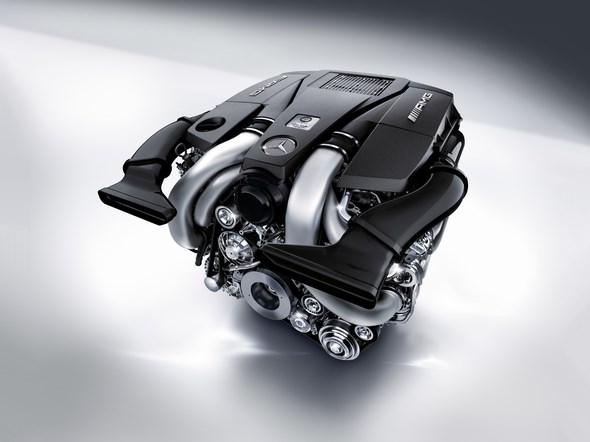
A new feature is assistance with parking perpendicular to the road. Active Parking Assist includes six ultrasonic sensors in each of the front and rear bumpers which measure the size of the parking space when driving past it.
PARKTRONIC provides visual and audible warnings of obstacles in front of and behind the vehicle, thus helping to avoid damage when manoeuvring.
The new S-Class Cabriolet features a reversing camera with a resolution of one megapixel and digital image transmission to the central display as standard.
The camera is installed under the folding Mercedes star on the boot lid, where it is protected from soiling. When reverse gear is engaged, the Mercedes star is raised, uncovering the reversing camera.
The 360° camera system is available as an option. This comprises a close-range camera system incorporating several cameras to assist with parking and manoeuvring.
In addition to the reversing camera, it allows monitoring of the areas alongside and directly ahead of the vehicle and can thus prevent collisions whilst manoeuvring.
The camera system comprises a network of four cameras and a control unit which is able to present a bird’s eye view of the vehicle and its surroundings.
Passive safety: Restraint systems and roll-over protection
Always in the optimum position
Factors that determine the occupants’ risk of injury in accidents include the crash resistance of the car’s body, the stability of the passenger cell and the qualities of the restraint systems.
The new S-Class Cabriolet offers a fully pyrotechnic roll-over protection system, nine standard-fit airbags and four belt tensioners and belt force limiters as standard.
Innovations in the two-door model include an intelligent belt feeder system.
On detecting an impending danger of the vehicle rolling over, the airbag control unit sends a corresponding signal to the roll over protection system.
This is quickly extended behind the rear head restraints, helping to maintain a safe passenger compartment.
The roll bars are extended not by spring force, but – for the first time on a Mercedes-Benz – by pyrotechnical means, using a gas generator.
This is made possible by state-of-the-art yaw rate sensors which, in contrast to the previously employed tilting cone sensors, virtually rule out incorrect actuation.
In keeping with the S-Class Cabriolet’s high design quality, there are no tear lines in the panelling behind the rear head restraints.
Standard equipment for both the driver and front passenger includes a three-point seat belt with pyrotechnic inertia-reel tightening with force limiter.
A newly developed belt feeder system offers the ultimate in user friendliness while also providing for an elegant side line. Adaptive to the seat position, the belt feeder automatically moves the seat belt to within easy reach of the driver or front passenger.
The belt feeder returns to its original position once the occupant has attached the seat belt. If nobody is sitting in the front-passenger seat, the intelligent belt feeder system is likewise retracted automatically.
In addition to this, there is a separate button on the dashboard for requesting the seat belt again when required.
Three-point seat belts with inertia-reel tensioner and belt force limiter are fitted for the rear passengers in the two outer seats.
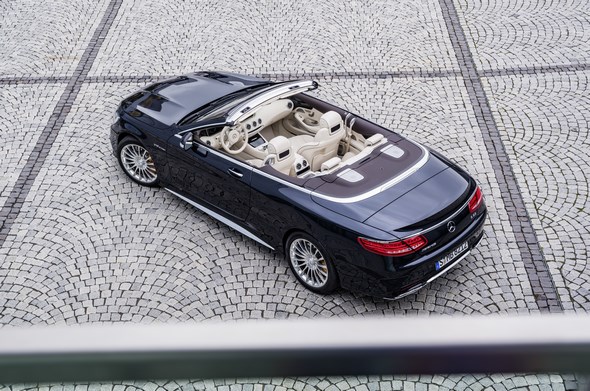
Nine airbags as standard: head protection in the Cabriolet as well
The driver airbag is equipped with a two-stage gas generator. Two performance stages can be activated depending on the detected vehicle deceleration rates, with a time delay between ignition of the first and second stages.
As a special feature in addition to the two-stage gas generator, the front passenger airbag has a pyrotechnically activated adaptation stage.
The damping effect when the occupant is immersed in the airbag is stronger or weaker as required, depending on seating position and level of inflation.
Standard equipment furthermore includes a driver’s kneebag which reduces the load on the driver’s lower extremities in the event of a frontal impact and also benefits overall kinematics.
The kneebag module with the folded airbag is housed in the lower dashboard cover below the steering column tube.
The headbag for the front passengers is a new development. It is installed in the beltline area of the doors and provides extensive protection for the front passengers’ head impact area.
The thorax-pelvis sidebags for driver and front passenger are integrated in the backrests of the front seats.
The sidebags in the rear are integrated into the bodyshell in the area of the rear interior side panels and serve to protect the rear passengers’ heads.
Triggering of the side protection systems is controlled by an electronic triggering device, which can detect and assess a side collision with the help of a central acceleration sensor, additional satellite sensors in vehicle lateral direction and pressure sensors in the doors.
Furthermore, the belt tensioners are triggered together with sidebags and headbags if a side collision is detected and together with the headbags if roll-over is detected.
Pressure sensors in the front bumper detect a possible collision with a pedestrian and trigger the reversible active bonnet when necessary.
The lights: LED Intelligent Light System
Better night-time visibility
The new S-Class Cabriolet requires no bulbs whatsoever, instead featuring LED technology throughout.
The lighting’s multi-level functionality is another innovation: out of consideration for road users behind, the intensity of the brake lights is reduced at night or while waiting at traffic lights.
Visibility is enhanced by Adaptive Highbeam Assist Plus and optional Night View Assist Plus with a spotlight function.
Like the S-Class Saloon, the new Cabriolet model no longer has a single bulb on board. LEDs are responsible for illuminating the road, the vehicle, the interior and the boot.
The new energy-saving LED low-beam headlamps, for instance, require 34 watts to produce the same light output, making them notably more efficient than halogen (120 watts) and xenon light sources (84 watts, all figures per vehicle).
This means that it is possible to save up to 0.05 litres of fuel per 100 kilometres or 2.1 grams of CO2 per kilometre, compared with a vehicle with halogen low-beam headlamps.
New, powerful single-chip LEDs and a newly developed projection module in the headlamp, where light rays are diverted and reflected, contribute decisively to the increased efficiency.
Standard equipment for all S-Class Cabriolet models includes High Performance LED headlamps, the Intelligent Light System and Adaptive Highbeam Assist Plus.
Night View Assist Plus with pedestrian detection and spotlight function is available as an optional extra.
The rearview mirror and the exterior mirror on the driver’s side feature an automatic dimming function as standard.
An emergency light function prevents failure of the entire front or rear lighting. By way of example, a certain number of lights are switched on if a bus system or a control unit fails.
Safety is further enhanced by the standby light function: if light functions relevant to safety fail, other functions are activated to replace them.
Permanent high beam with no dazzle: Adaptive Highbeam Assist Plus
Adaptive Highbeam Assist Plus allows the high-beam headlamps to be kept on permanently while driving by masking out any other road users detected in the beams’ cone of light.
If the camera-based system registers either oncoming traffic or vehicles ahead, it will adapt the light distribution according to the traffic situation when high beam is switched on.
Consequently, the driver can leave the high-beam headlamps on at all times and use their full range without irritating or even endangering other road users.
There is no need to switch them on and off manually, resulting in a significant increase in the overall driving time with high beam.
Adaptive Highbeam Assist Plus likewise makes use of the stereo camera also employed by other assistance systems. If its image recognition algorithm picks up a vehicle that is oncoming or driving ahead, it actuates a mechanism in the headlamp module.
This masks the section of the LED headlamps’ high-beam cone of light where there are other vehicles, to prevent their drivers from being dazzled.
If road users are detected outside the area that can be masked – for instance when cornering with multiple vehicles in the headlamps’ beams – the system will switch to the familiar system of headlamp range control using the low-beam headlamps.
Possible backglare caused by increased use of the main beam and highly reflective signs at the side of the road are also detected and eliminated by dimming the headlamps accordingly.
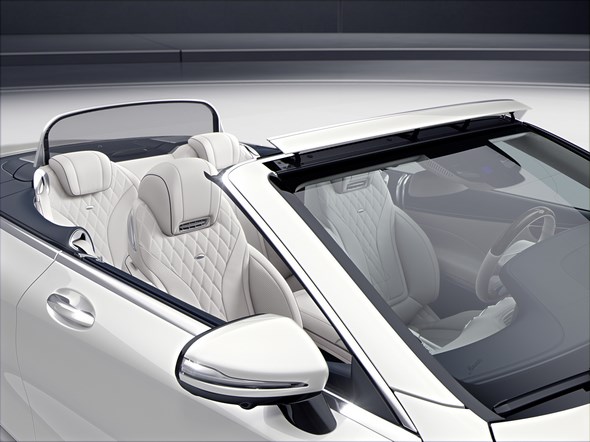
Considerate to others: tail lights with automatic intensity control
The new S-Class Cabriolet shows itself to be highly considerate of its fellow road users in another way, too: thanks to multi-level functionality, the brake lights and indicators are operated at varying intensities depending on the current driving state and the brightness of the environment (day/night).
If the Mercedes driver presses the brake pedal while stopped at traffic lights at night, for instance, the brightness of the brake lights will be automatically dimmed to avoid dazzling anyone behind.
The light distribution is broadened to ensure the lights do not become too dark and continue to fulfil all legal requirements, of course.
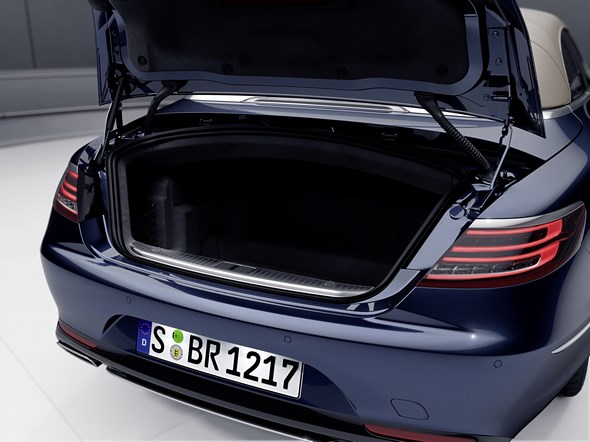
Detects pedestrians and animals: advanced Night View Assist Plus
Night View Assist Plus is capable of detecting not just pedestrians in potentially hazardous positions in front of the vehicle, but large animals too.
As a third-generation night vision system, it issues a warning in particularly relevant situations (darkness, unlit roads at speeds exceeding 60 km/h) by automatically switching from the speedometer to a brilliant night view image in the instrument cluster display.
Pedestrians or animals detected ahead are highlighted in red in this image.
In such situations the spotlight function is additionally used to repeatedly flash pedestrians in the warning zone by means of a special module in the front headlamps.
This attracts the driver’s attention to the danger, and the person at the road edge is warned at the same time. Animals are intentionally not flashed, as their reaction to light impulses is unpredictable.
The greyscale image can be switched on at any time; pedestrian detection, and the corresponding highlighting, are now also available in urban areas during darkness (illuminated roads, speed less than 60 km/h) if the greyscale image is activated permanently.
An additional (long-distance) infrared sensor in the radiator grille helps to enhance the proven Mercedes-Benz night-vision technology.
This enables pedestrians to be detected at a distance of up to 160 metres, and animals such as deer, horses or cows at up to 100 metres.
Two separate light sources in the headlamps illuminate the road ahead of the vehicle with invisible infrared light.
A (short-range) infrared camera behind the windscreen near the rear-view mirror is able to generate a brilliant greyscale image in the instrument cluster display.
This can also be displayed permanently if required by pressing a direct-selection button.
Drive system: 9G-TRONIC as standard
The most efficient V8 petrol model in the luxury class
The S-Class Cabriolet is initially available with the 4663 cc V8 biturbo engine featuring BlueDIRECT technology.
The emotive sound of the exhaust system makes a decisive contribution to the sporty driving experience.
The V8 biturbo engine generates an output of 335 kW (455 hp) from a displacement of 4663 cc. Peak torque stands at 700 Nm in the broad range between 1800 and 3500 rpm.
The NEDC fuel consumption (combined) of the Cabriolet is 8.5 l/100 km (premium unleaded petrol), while CO2 emissions are 199 g/km.
Outstanding efficiency does not come at the cost of supreme performance: The S 500 Cabriolet completes the sprint from 0 to 100 km/h in an impressive 4.6 seconds and goes on to reach a top speed of 250 km/h (electronically governed).
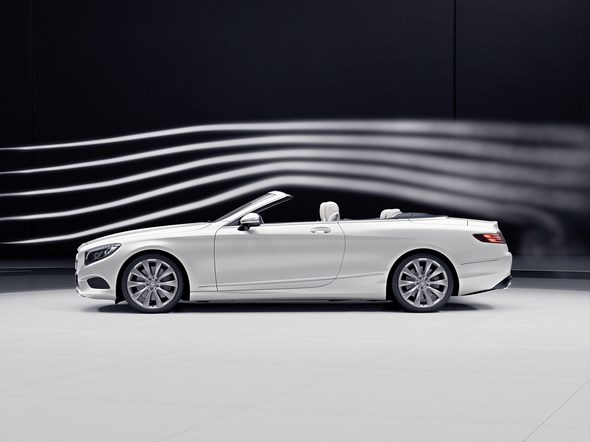
Stand-out features of the 90-degree V8 engine:
- Twin turbochargers
- The spray-guided combustion system with third-generation direct injection known as BlueDIRECT, also featuring piezo injectors and multispark ignition
- Low component weights
- Low mechanical power loss thanks to tribological (friction-reducing) measures at all bearing points and friction components of the barrel/piston and the control drive
- Low fluidic and thermal power loss thanks to on-demand control of the oil circuit and ancillary components plus integrated thermal management
- Very low NVH (Noise, Vibration and Harshness)
- Low specific consumption and low untreated emissions
The data at a glance:
| Model | S 500 Cabriolet |
| Number of cylinders/arrangement | 8/V |
| Displacement (cc) | 4663 |
| Compression ratio | 10.5 |
| max. charge pressure (mbar) | 900 |
| Rated output (kW/hp at rpm) | 335/455 at 5250-5500 |
| Rated torque (Nm at rpm) | 700 at 1800-3500 |
| NEDC fuel consumption (l/100 km) urban/extra-urban/combined | 11.8/6.8/8.5 |
| Combined CO2 emissions (g/km) | 199 |
| Efficiency class | C |
| Acceleration 0-100 km/h (s) | 4.6 |
| Top speed (km/h)1 | 250 |
1 Electronically limited
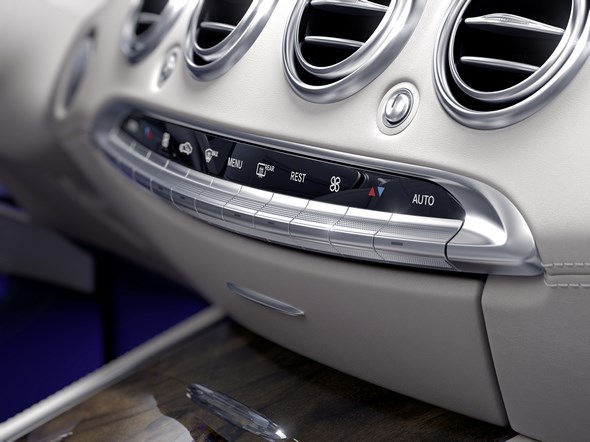
Emotively sporty sound: exhaust system with flaps
The emotive sound of the exhaust system makes a decisive contribution to the sporty driving experience.
The deeper sound components ensure a fuller, sportier sound. In the transversally positioned rear silencer of the twin-pipe exhaust system there are two flaps that can be opened and closed pneumatically depending on the engine speed.
When the flaps are open the exhaust gases are conducted through the rear silencer along a different path so that the vehicle sound becomes more powerful.
The switching point of the flaps depends upon the selected drive mode – in S mode, the flaps open earlier than in E mode. As soon as the S-Class Cabriolet engine starts up, the power of its sound can be heard.
Thermal management: two independent cooling circuits
The new S-Class Cabriolet has two independently operating coolant circuits. The high-temperature circuit cools the engine, cylinder head, turbochargers and exhaust gas recirculation valves, while the low-temperature circuit regulates the temperature of the charge air and the transmission.
Both circuits are completely separate from each other to ensure that coolant quality is maintained over the long term.
An electronic coolant pump in the low-temperature cooling circuit performs an efficiency-enhancing function, for on-demand control of the charge-air, transmission and electronic system temperatures.
An electronic regulating valve distributes the mass coolant flow as required for charge-air, transmission and electronic system cooling.
To minimise the energy required for the cooling system depending on the driving situation, fully controllable electrical components such as the electrical suction-type fan, low-temperature coolant pump and regulating valve are linked via LIN-BUS to the engine incl. turbocharger, the EGR and air intake system plus the transmission and the thermal comfort systems.
Under part load with a corresponding vehicle speed, for example, the fan speed is greatly reduced, while the adaptation of the valve position and pump speed ensures that each component requiring cooling only receives as much coolant as is actually necessary to comply with the temperature limits.
New 9G-TRONIC nine-speed automatic transmission: comfort and efficiency
The 9G-TRONIC automatic transmission offers a high level of efficiency. The broad ratio spread of 9.15 for gears one to nine allows a low engine speed and is a decisive factor behind the high level of energy efficiency and ride comfort.
Short shift and response times ensure optimum spontaneity combined with extremely smooth gear changes.
In manual mode and S mode in particular, 9G-TRONIC responds immediately and enhances driving pleasure. A gliding function is also available.
The particular ease of shifting of the new 9G-TRONIC comes courtesy of a comprehensive package of measures. These include the novel direct control system which enables short, barely perceptible gear changes.
The combination of twin-turbine torsional damper and centrifugal pendulum technology in the torque converter ensures outstanding drive comfort.
Together with the extended gear ratio spread, higher road speeds can be driven at lower engine speed for excellent comfort.
A further focus of development work was the issue of “compact lightweight construction”. Despite two additional gears and a maximum transferable torque of up to 1000 newton metres, the new automatic transmission requires as little installation space as its predecessor and is also lighter in weight.
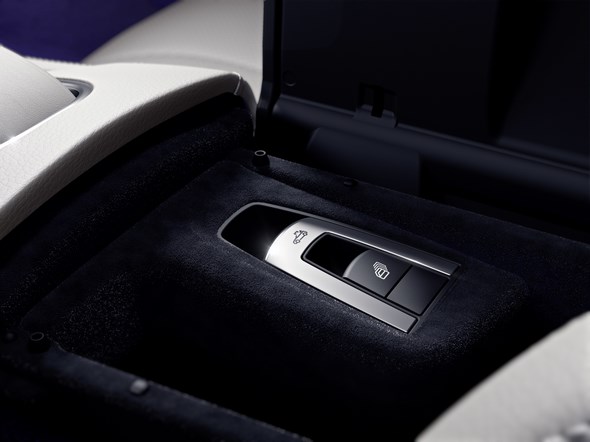
The two-piece housing design has been retained: the torque converter housing is made of lightweight aluminium, while the transmission housing with weight-optimised plastic oil pan is made of an even lighter magnesium alloy.
Nine gears are implemented with a minimal number of planetary gear sets and shift elements: only four simple planetary gear sets and six shift elements are necessary.
Three speed sensors monitor operation and provide the transmission control system with corresponding data for effective shifting.
Here it is possible for several gears to be jumped when accelerating or decelerating, should the driving conditions call for it.
To ensure the reliable and at the same time energy-efficient supply of long-lasting and shear-resistant, second-generation synthetic fuel economy engine oil, the new automatic transmission is equipped with two pumps.
The considerably smaller mechanical main pump, featuring an off-axis design, is located next to the main shaft and is chain-driven and fed by a separate electric auxiliary pump.
This design enables the flow of lubrication and coolant to be controlled actively on demand and also means that the 9G-TRONIC can benefit from a start/stop system.
Thanks to the world’s first direct control system in a planetary automatic transmission with nine gears, it has also been possible to significantly increase hydraulic efficiency within the transmission.
The higher number of gears and the broader gear ratio spread help to increase drive comfort and allow a significant enhancement to be achieved in terms of converting engine power into traction.
Suspension: air suspension as standard
Comfortable and sporty gliding
The S-Class Cabriolet features the enhanced full-support AIRMATIC air suspension with continuously variable damping control as standard.
The front axle features four-link suspension. Its key characteristics include two individual links (torque strut and spring link) in the lower link plane.
The transversely situated forged-aluminium spring link carries the spring strut. The anti-roll bar is connected directly on the steering knuckle, while the forward-sloping torque strut is made of forged aluminium.
A wishbone located high above the lower link plane performs further wheel location functions. This link is also made of forged aluminium, as is the steering knuckle which connects the upper and lower link planes.
The fourth link is the track rod which forms part of the rack-and-pinion steering system. The transversely situated steering gear is located in front of the wheel’s centre.
The arrangement and design of the wheel location components offer favourable characteristics for the axle kinematics: the kingpin inclination is close to the wheel centre.
This provides for large longitudinal force leverage, thus minimising sensitivity to tyre imbalances and fluctuations in braking force.
The lower front axle components, the steering gear and the engine mounts are linked with an assembly carrier. This integral carrier, made from high-strength sheet aluminium, is directly bolted to the body.
Due to the ideal wheel location qualities, the S-Class Cabriolet features a multi-link rear suspension attached to an aluminium subframe.
Consistent lightweight construction minimises the weight of the unsprung masses. Four of the five wheel-locating links are made of forged aluminium, as is the hub carrier.
The spring link that carries the spring strut is made of single-ply sheet aluminium. In the standard configuration, the rear axle with air suspension features a torsion-bar stabiliser which is directly connected to the rear axle carrier.
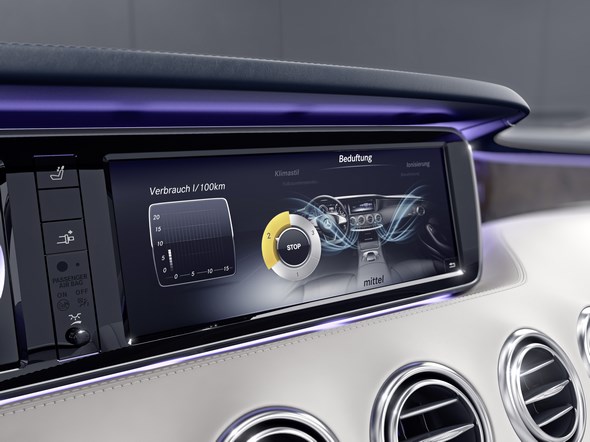
AIRMATIC: enhanced comfort and driving dynamics
The standard-fit full air suspension system AIRMATIC with continuously adaptive damping control allows the spring travel to be maintained whatever the vehicle load, by means of continuous level adjustment.
The vehicle level is lowered by a further 10 mm when driving at higher speed. Aerodynamic drag is reduced, and handling stability is improved by the car’s low centre of gravity.
The lower control panel on the centre console allows the driver to raise the vehicle level by 40 millimetres on poor road surfaces or when confronted with a tricky garage entrance, for example.
The Adaptive Damping System features as standard. This fully automatic, electronically controlled system adjusts the damping at each wheel to the current requirements.
The single-tube dampers have two valves for the rebound and compression stages respectively, and the damping is adapted continuously.
The ideal operating point can be selected at all times on the basis of a broad scope of information relating to acceleration, vehicle level or vehicle speed, for example.
A switch on the centre console allows the driver to select from two different damper configurations: “Sport” and “Comfort”.
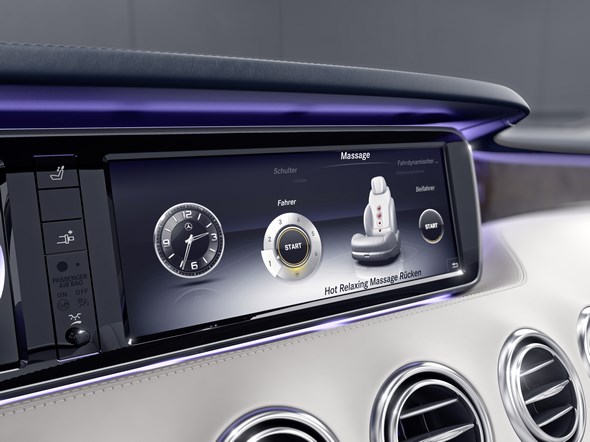
Steering: Electro-mechanical Direct-Steer system and steering assistance
The new S-Class Cabriolet comes with an electro-mechanical Direct-Steer system as standard. As well as providing for a precise and comfortable steering experience, the steering system has a major impact on overall efficiency, since it only requires energy when the vehicle is actually being steered.
In the new steering system, the steering gear and the supporting servomotor form a single compact unit and are mounted on an extremely rigid and low-weight integral support frame made of aluminium which is positioned in front of the wheel’s centreline.
The steering gear is designed as a Direct-Steer system, which means that the steering ratio becomes noticeably more direct as the steering angle increases.
This enhances the vehicle’s handling and agility substantially.
The steering assistance function can help to stabilise the vehicle. An assisting steering wheel torque is determined depending on the driving conditions, and a corresponding steering impulse is triggered.
The function never overrules the driver, but instead indicates the direction in which to steer to stabilise the vehicle. In the event of oversteer, the steering assistance system prompts the driver to countersteer using the steering wheel until the vehicle has stabilised again.
If the vehicle is braked on a road surface with different friction (µ-split) on the left and right, this generates a yawing impulse which turns the vehicle in the direction of the higher friction.
The steering assistance system prompts the driver to turn the steering wheel in the appropriate direction to compensate for the yaw caused by the different friction.
The electro-mechanical steering gear also allows driving assistance systems such as Active Parking Assist incl. PARKTRONIC and DISTRONIC PLUS with Steering Assist to be implemented.
The Cabriolet is equipped with a electrically height- and reach-adjustable steering column including an entry-aid function.
The adjustment ranges measured from the basic position of the steering wheel are +/- 25 mm for height and 25 mm/35 mm (fore/aft) for reach.
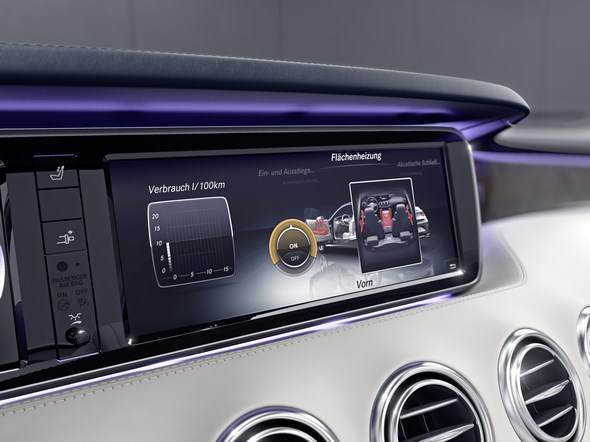
Brakes: large discs, a wealth of assistance functions
Large, internally ventilated brake discs on the front and rear axle create the technical basis for safe and reliable braking by the electronic brake control system ADAPTIVE BRAKE.
Multipiece brake discs have been developed to reduce the unsprung masses. On these discs, the friction ring (made of cast iron) and the brake disc bowl (made of sheet steel) are pressed by toothing.
They have a diameter of 370 mm (front) or 360 mm (rear).
An electric parking brake is fitted as standard on the S-Class Cabriolet. A combined floating brake calliper with an electric parking brake function is used at the rear axle.
With ADAPTIVE BRAKE, the S-Class Cabriolet offers a wealth of assistance functions. One example of these is the practical HOLD function: after braking to a standstill, briefly pressing the brake pedal a little further is all that is required to activate this function.
The car is then held by the brakes, even if the driver’s foot is taken off the brake pedal. The HOLD function is deactivated automatically when the car moves off.
If the driver’s foot moves abruptly from the accelerator to the brake pedal before an emergency stop, the brake system increases the pressure in the brake lines and already brings the pads into contact with the brake discs so that maximum braking power is available as soon as the driver hits the brake pedal.
This priming of the brakes allows the system to assist the standard-fit Brake Assist system.
ADAPTIVE BRAKE also brings safety benefits in the wet: the system briefly applies the brakes at regular intervals to wipe the film of water from the brake discs and ensure that the brakes are able to perform at their peak.
The finely metered brake pulses are imperceptible to the driver. This automatic brake drying function is always activated after a certain period of windscreen wiper operation.
Finally, ADAPTIVE BRAKE assists the driver when starting on an uphill slope. When the sensors detect that the Cabriolet is stopped on an uphill slope, Hill Start Assist is activated automatically, briefly holding the brake pressure at a constant level so as to prevent the car from rolling backwards.
ESP® Dynamic Cornering Assist offers improved safety in critical cornering conditions. If the ESP® sensors detect an understeering tendency, the system performs specific braking intervention on the side of the vehicle which is on the inside of the bend.
This gives rise to gentle rotary movement of the vehicle around the vertical axis.
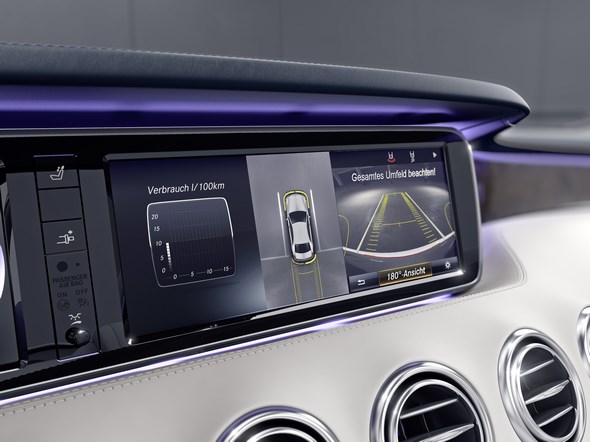
Wheels and tyres: up to 20 inches ex factory
The wheels available ex factory span the range from 18 to 20 inches. As standard the S-Class Cabriolet is fitted with ten-spoke light-alloy wheels: 8J x 18 ET 41 (front) and 8.5J x 18 ET 35.3 (rear) with 245/50 R18 tyres.
A number of further 18 and 19-inch wheels and tyres are available as optional extras. The largest wheels available ex factory are five-spoke or multi-spoke light-alloy wheels, size 8.5J x 20 ET 36/36.5 with 245/40 R20 tyres (front) and 9.5J x 20 ET 43.5/44 with 275/35 R20 tyres (rear).
A tyre pressure monitoring system which continuously monitors the pressure in all four tyres is standard equipment, with the data for each wheel shown on the instrument cluster display.
During a journey, sensors built into the wheels send out radio signals (433 MHz) with information about the air pressure, tyre temperature and direction of rotation plus an individual identification number to distinguish between the wheels.
The system detects newly fitted tyres automatically and assigns them to the correct position on the vehicle.
The information about direction of rotation received from the wheel sensors and the different signal strength of the rear wheels positioned closer to the receiving antenna and the front wheels positioned further away are evaluated for the purpose of automatic position detection.
The tyre pressure monitoring system can issue three different warning messages:
- “Correct tyre pressure” if the tyre inflation pressure drops slightly
- “Check tyres”, including an acoustic signal, if the tyre inflation pressure drops severely
- “Caution: tyre defect”, including an acoustic signal, if the tyre inflation pressure suddenly drops whilst driving.
Since the recommended tyre inflation pressures depend on the tyre size, the vehicle load and the maximum speed, the driver may need to adjust these pressures.
The tyre pressure monitoring system detects these changes automatically in most cases. If the tyre inflation is plausible, the reset tyre pressures are accepted as new setpoints by the system axle by axle after a few minutes of driving.
If the tyre inflation is implausible, the driver is prompted to correct the pressures. The driver can calibrate the tyre pressure monitoring system manually by entering the current pressures as new setpoints at the push of a button in the operating menu, under “Service/Tyre pressure”.
In countries that have adopted the ECE agreement, the “TIREFIT” breakdown kit incl. electrical compressor is specified as standard.
Run-flat tyres are provided for vehicles outside of the ECE to ensure continued mobility.
Multimedia features: Let the music play
Intuitive controls and the ultimate in listening pleasure
All the functions available on the central infotainment control panel can be optionally controlled using the touchpad.
In addition to this intuitive control, the functions of the new multimedia generation can be experienced through visualisation and animations.
A high-end surround sound system from Burmester® with 23 loudspeakers is optionally available, offering the ultimate in listening pleasure.
The optional touchpad gives the S-Class Cabriolet another fully-fledged and innovative input option in addition to the Controller, LINGUATRONIC voice-operated control and the control buttons on the steering wheel.
Users can choose at any time which input method they prefer. As on a smartphone, the touchpad located on the centre tunnel in front of the armrest allows all the functions of the infotainment system to be operated using finger gestures.
The touchpad also permits letters, numbers and special characters to be entered in handwriting – in any language covered by the infotainment system.
Diverse controls, e.g. for the multi-media system, are arrayed as keys in a semicircle in front of the central control element.
Mercedes-Benz COMAND Online with the high-resolution 12.3-inch (31.2 cm) media display is on board as standard.
With the exception of the navigation map (which always fills the complete display area), the graphic content of the central display is divided into a main area (2/3 on the right side of the display) and a supplementary area (1/3 on the left side of the display).
In standard configuration the supplementary area shows additional information about the selected main application, e.g. the artist and song title when the radio function is active, or the current station when the TV is active.
The COMAND Online functions include:
- Fast hard-disc navigation for the digitised areas of Europe, 3D navigation with topographic map display and photorealistic 3D buildings and 3D map rotations. Display of NASA satellite images. Automatic tailback avoidance by means of accurate and up-to-date “Live Traffic Information”, lane recommendation and following of pre-defined routes.
- Free use of integrated Mercedes-Benz Apps and option for calling up internet sites
- Integrated WLAN hotspot functionality to enable use of WLAN-capable devices in the vehicle (mobile phone required for internet use via WLAN).
- LINGUATRONIC voice control system for audio, telephone, navigation and music search.
- Bluetooth® interface with hands-free function, SMS/email read and write function and Bluetooth® audio streaming for music transfer
- Radio with twin tuner, CD/DVD drive, two USB interfaces (in the centre console), slot for SDHC memory cards, 10 GB memory (Music Register) for compressed audio and video files, song tagging, “Play More Like This”, Coverflow display
- DVD Video, Picture Viewer for photos from SD cards or USB storage devices
- Digital Owner’s Manual for the specific vehicle concerned, including animations
- Touch-sensitive telephone keypad
- 12 user-assignable favourite functions
- Operation of vehicle functions and display of consumption information
Available optional equipment includes
- TV receiver for digital reception
- Digital radio
- 6-disc DVD changer
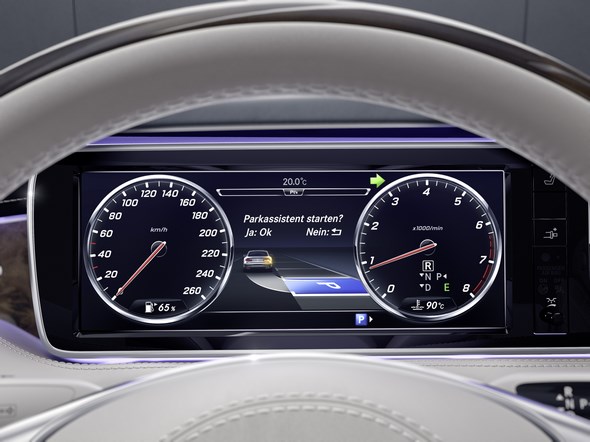
With Frontbass and up to 23 loudspeakers: the sound systems
The common feature of all the audio systems is the innovative Frontbass system developed by Mercedes-Benz: the woofers are mounted in the firewall, and use the space within the cross-member and side member as a resonance chamber of almost 40 litres.
The mid-range speakers in the doors are relocated upwards. This improves sound brilliance and allows additional stowage space in the doors.
As alternatives to the standard sound system with ten loudspeakers, two very high-quality audio systems are available which were developed together with the high-end audio specialist Burmester: the Burmester® surround sound system and the Burmester® high-end surround sound system.
The Burmester® high-end surround sound system provides a unique in-car listening experience by virtue of 23 high-performance speakers and 24 separate amplifier channels with a total output of 1520 watts.
Its intelligent combination of analogue and digital amplifier technologies leads to an unparalleled mix of fine, natural sounds and high power reserves.
While sophisticated filter circuits ensure the best possible detailed reproduction in the medium- and high-frequency ranges, the digital amplifier masters the highest dynamic peaks despite its compact dimensions.
The result is the greatest possible resolution and fine detail, combined with an impressive impulse reproduction. It produces a warm, substantial sound experience with an imposing bass backdrop.
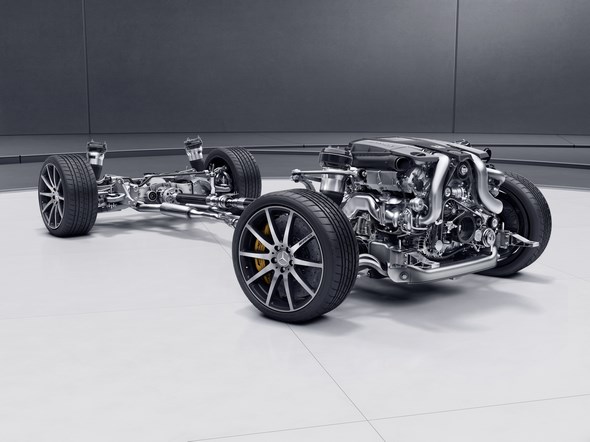
The S-Class family: covering every need
A model family that sets new standards
2013 marked the launch of the S-Class – the most successful luxury-class series in the world. The model range has since undergone continual expansion, and with the Cabriolet it now comprises six basic models along with additional special versions, in particular from Mercedes-AMG.
With three development priorities focusing on “Intelligent Drive”, “Efficient Technology” and “Essence of Luxury”, the new Mercedes-Benz S-Class broadened technical horizons on many levels.
It was introduced in July 2013, initially as a Saloon with a long (V 222) and normal (W 222) wheelbase.
The highlights on board included the COMAND Online system; the cockpit is equipped with two 12.3-inch LCD screens. A number of new safety systems went into series production: Cross-Traffic Assist, Lane Keeping Assist and rear belts with airbags.
The S-Class was also the first vehicle worldwide
- with LEDs throughout instead of bulbs.
- with an anticipatory active suspension based on a stereo camera: MAGIC BODY CONTROL with ROAD SURFACE SCAN.
- with a wrong-way driver warning system.
A further highlight in July 2014 was the first S-Class with plug-in hybrid drive system. The S 500 e was the first luxury saloon to combine the performance of a V8 with the fuel consumption of a compact model (2.8 litres/per 100 km) and to offer an all-electric range of 33 kilometres.
December 2014 saw the premiere of the company’s new flagship, the Mercedes‑Maybach S-Class. The wheelbase of the saloon, the quietest in the world for rear-seat passengers, has been extended by 200 mm, the full extent of which benefits those sitting in the back. The roof line also meant more headroom.
The seat belt buckle extender, beltbag (both part of the PRE-SAFE® rear package, beltbag also available separately) and seat cushion airbag are innovative safety features in the rear of the Mercedes-Maybach S-Class that contribute to its unique flair.
The S-Class Coupé was launched in September 2014. Boasting a stylish appearance, exclusive equipment and refined sportiness, the Coupé combines the classic proportions of a Gran Turismo with modern luxury and state-of-the-art technology.
The world-first MAGIC BODY CONTROL suspension system featuring the innovative curve inclination function was now available.
The Mercedes-Maybach Pullman was unveiled at the Geneva International Motor Show in March 2015. Its special status is indicated by its length of 6.50 metres alone.
It provides the space for a generously-sized and tastefully-appointed club lounge in the rear, with a multitude of creature comforts fitted as standard, thereby ensuring the chauffeur-driven limousine lives up to today’s expectations of what constitutes total exclusivity and luxury.
The VIP occupants sit on two standard-specification executive seats facing the direction of travel. They can enjoy the greatest legroom in the segment; and can get into and out of the car with the greatest of ease and comfort.
As is typical for a Pullman, the four passengers can sit facing each other in the compartment with an electrically-operated partition window.
The Mercedes-Maybach S 600 Guard is to follow in the spring of 2016. The special-protection version of the Mercedes-Maybach is the first vehicle to be certified with the highest ballistic protection level VR10 for civilian vehicles.
History: Around 100 years of luxury cabriolets
Comeback of a dream car
The last S-Class Cabriolet in the 1960s was a dream car of its time and retains this cachet to the present day. All open-top luxury cars from Mercedes-Benz are at the top of collectors’ wish lists today.
The new S-Class Cabriolet is carrying the long and successful tradition of Mercedes-Benz luxury-segment cabriolets into the future.
Even back in the 1920s the luxury cabriolets from Stuttgart combined the freedom of open-top motoring with the comfort and safety of a Mercedes-Benz Saloon.
From the start of post-war production the top models from Mercedes-Benz were also available in the particularly exclusive variant as a cabriolet.
These models included the 170 S (W 136) from 1949, the 220 (W 187) from 1951 and the 300 S (W 188) from 1952.
After the “Ponton” cabriolets 220 S (W 180) and 220 SE (W 128) built from 1956 to 1960, in 1961 the 220 SE Cabriolet of the model series W 111 was launched, a particularly elegant, open-top four-seater, the design of which is still considered timeless to this day.
In this ten-year production period Mercedes-Benz offered five different models in these model series: the 220 SE, 250 SE, 300 SE (W 112), 280 SE and, as a late top model, the eight-cylinder 280 SE 3.5 – in total 7013 units of these five cabriolets were manufactured in Sindelfingen.
For the time being there was no open-top luxury-segment car in the Mercedes-Benz model range to follow this generation: rather, it was the new SL from model series 107 from 1971 onwards which cultivated the tradition of open-top motoring in the Stuttgart brand’s cars – as a two-seater.
The cabriolets from Mercedes-Benz are today amongst the most sought-after classic cars – and the prices have developed accordingly. Examples of this are the Cabriolets from model series 111 the values of which are cited by the renowned American Hagerty Insurance’s price guide.
In its estimation a 280 SE 3.5 from the final year of construction, 1971, in condition 2 today has a value of around 290,000 US$ – ten years ago the figure was some 115,000 US$.
But that is by no means the pinnacle: for instance, a specimen of this model in excellent condition was auctioned last August by RM Auctions for US$ 429,000.
The last six-cylinder 280 SE model (1969) in the same condition is valued today by Hagerty at approx. US$ 75,000 – as compared to around US$ 45,000 ten years ago.
Early 220 SE models are around the same level, with a current value of some US$ 84,000.
The new Mercedes-AMG S 63 4MATIC Cabriolet
The ultimate dream car
Affalterbach. Mercedes-Benz is presenting a superlative dream car in the guise of the S 63 4MATIC Cabriolet.
For the first time in its 49-year history, Mercedes-Benz’s sports-car and performance brand is offering a four-seater cabriolet in the S-Class segment, which augments the product portfolio with an attractive alternative for car enthusiasts with a passion for performance and luxury.
The AMG 5.5-litre V8 biturbo engine with an output of 430 kW (585 hp) and peak torque of 900 Nm, the AMG Performance 4MATIC all-wheel drive with rear-biased torque split as standard, the acceleration from 0 to 100 km/h in 3.9 seconds and the high-performance composite brake system form the basis for the brand’s hallmark Driving Performance combined with opulent appointments and exclusive materials in the interior.
High-performance technology coupled with expressive exterior and interior design: It is immediately apparent that the new S 63 4MATIC Cabriolet is built by car enthusiasts for car enthusiasts.
“The new S 63 Cabriolet is another fascinating AMG dream car from Affalterbach,” says Tobias Moers, Chairman of the Board of Management of Mercedes-AMG GmbH.
“The new model demonstrates in impressive style that we are keeping our foot firmly on the gas. We are continuing our model initiative with a vengeance – in all market segments.”
Intelligent AMG Lightweight Performance
The basis for the vehicle’s superior and dynamic character is provided by the particularly rigid bodyshell structure featuring innovative solutions such as the luggage compartment bulkhead made of magnesium.
Furthermore, the weight has been limited by the use of a lightweight lithium-ion battery, AMG light-alloy wheels produced by means of a sophisticated forging process and the weight-optimised AMG high-performance composite brake system – all of which makes perfect sense given the fact that large parts of the shell, front section and rear end are made of aluminium.
AMG 5.5-litre V8 biturbo engine: superior and efficient
In terms of maximum output, torque and fuel consumption, the AMG 5.5-litre V8 biturbo engine remains one of the most efficient series-produced V8 engines in the world.
With an output of 430 kW (585 hp) and 900 Newton metres of torque, the AMG eight-cylinder engine meets the very highest standards.
And the same goes for its performance: the S 63 Cabriolet accelerates from 0 to 100 km/h in 3.9 seconds and has a top speed of 250 km/h (electronically limited).
NEDC fuel consumption of 10.4 litres per 100 kilometres makes the two-door model the most fuel-efficient model in its competitive segment.
Which just goes to show that performance, efficiency and environmental compatibility need not be mutually exclusive aims.
The data at a glance:
| Mercedes-AMG S 63 4MATIC Cabriolet* | |
| Displacement | 5461 cc |
| Output | 430 kW (585 hp) at 5500 rpm |
| Peak torque | 900 Nm at 2250-3750 rpm |
| Fuel consumption – urban/extra-urban/combined | 14.3/8.2/10.4 l/100 km |
| CO2 emissions – combined | 244 g/km |
| Efficiency class | E |
| Kerb weight (according to DIN/EC) | 2110 kg** / 2185 kg*** |
| Power-to-weight ratio | 3.61 kg/hp |
| Acceleration 0-100 km/h | 3.9 s |
| Top speed | 250 km/h**** |
*Only available with left-hand drive; ** Ready-to-drive condition (fuel tank 90% full, without driver and luggage); *** Ready-to-drive condition (fuel tank 90% full, with driver (68 kg) and luggage (7 kg));
**** Electronically limited.
Exhaust system with automatic exhaust flaps
Emotional and sporty or restrained for long distances – the S 63 Cabriolet also meets all driver wishes where acoustics are concerned: The exhaust system has automatic logic-controlled exhaust flaps in both rear silencers.
When the transmission is in “C” (Controlled Efficiency) mode, the flaps remain closed in most situations, in which case the eight-cylinder biturbo engine’s sound is more understated.
In “S” (Sport) and “M” (Manual) modes, the exhaust flaps open earlier and more spontaneously, especially if the driver prefers a dynamic driving style. The effect: an emotional, signature AMG engine sound.
“One Man ‑ One Engine”: a tradition of hand-built excellence
The biturbo eight-cylinder engine of the S 63 Cabriolet is fitted by hand in the hand-finishing section of AMG’s production plant in Affalterbach based on the “One Man – One Engine” philosophy.
This means that each engine is assembled by a highly qualified technician who applies the strictest quality standards.
This technician is responsible for everything from installing the crankshaft in the engine block and assembling the camshafts to wiring the engine and filling it with engine oil ‑ as clearly evidenced by the signature on the AMG engine badge.
Electronic documentation of the entire production process
During the assembly process, each engine undergoes a series of tests in which it is examined for oil and water leaks.
The entire fuel system is likewise checked for leaks ‑ to the extent that even individual gas molecules can be detected.
All the engine functions are then examined on the “cold-test bench” using simulated resistances and pressurisation as well as the very latest resonance and airborne noise measurement methods.
And finally a fully automatic image processing system is used to check the delivery condition of the completed engine.
In addition to this, the assembly process is controlled and documented by the AMG Trace System. This system allows full documentation of various process parameters such as the tightening torques, angles and curves of all bolted connections, fluid levels, component and batch information, and test results.
Individuality: AMG SPEEDSHIFT MCT 7-speed sports transmission
The AMG SPEEDSHIFT MCT 7-speed sports transmission combines perfectly with the V8 biturbo engine.
Drivers can configure their own personal set-up, depending on their driving style. There are three modes to choose from: “C” (Controlled Efficiency), “S” (Sport) and “M” (Manual).
The ECO start/stop function features as standard and is activated in transmission mode “C”.
Performance-oriented AMG 4MATIC all-wheel drive
There are two variants of the S 63 Cabriolet available: with rear-wheel drive (as RHD version only) or with the performance-oriented AMG 4MATIC all-wheel drive (as LHD version).
The combination of S-Class Cabriolet and 4MATIC is exclusive to the AMG variant. The drive distributes 33 percent of the engine torque to the front axle and 67 percent to the rear axle.
This rear-biased power distribution provides for the signature AMG high driving dynamics and superlative driving enjoyment, and improves acceleration in all driving situations, including from a standing start.
The all-wheel drive also enhances driving safety on wet or wintry road surfaces.
AIRMATIC air suspension
The AMG specialists have also pulled out all the stops when it comes to the suspension: The S 63 Cabriolet comes with the AIRMATIC full-support air suspension featuring ADS PLUS adaptive damping, which can be preset to “Sport” or “Comfort”.
At the touch of a button, the special configurations of these two programmes enable outstanding agility and dynamics or unlimited comfort on long journeys and smooth cruising at low speeds.
Specific front axle kinematics – including a higher camber, a larger anti-roll bar and a stiffer subframe carrier on the rear axle – have also been developed for the Cabriolet.
The AMG-specific elastokinematics and parameterisation of the continuously variable damper control, the lower air volume of the air suspension system and the progressive piston geometry nip unpleasant rolling and pitching in the bud.
It is also possible to raise the vehicle’s level by 30 millimetres on poor surfaces. The chassis is lowered again automatically in “Sport” mode and from a speed of 120 km/h in “Controlled Efficiency” mode.
Systematic lightweight design: AMG forged wheels as standard
The S 63 Cabriolet is equipped with forged AMG light-alloy wheels as standard. This forged design provides for extremely strong and particularly light wheels.
The resultant lower unsprung masses give rise to advantages in terms of handling and spring/damper element response.
In the standard specification, the S 63 Cabriolet is fitted with multi-spoke forged wheels painted in titanium grey with a high-sheen finish – 8.5 J x 19 at the front and 9.5 J x 19 at the rear, with 255/45 R 19 and 285/40 R 19 tyres respectively.
Forged wheels are available as optional extras from the AMG Performance Studio, in size 8.5 J x 20 at the front and 9.5 J x 20 at the rear, fitted with tyres in size 255/40 R 20 and 285/35 R 20 respectively.
Optional AMG ceramic high-performance composite brake system
Short stopping distances and rapid deceleration are a given for the S 63 Cabriolet, which is equipped with a weight-optimised, fade-resistant high-performance composite brake system.
A ceramic high-performance composite brake system is available as an option. The design, which is more than 20 percent lighter, ensures lower unsprung masses as well as enhanced driving dynamics, agility and ride comfort.
Design as an expression of sportiness and performance
The S 63 Cabriolet also boasts exciting looks to emphasise its sporty performance: The design is a stage for the exciting technology at the heart of the new dream car.
Numerous exquisitely designed aerodynamic elements underscore the outstanding driving dynamics: the front end is dominated by the three-dimensional “twin-blade” radiator grille in silver chrome.
Under the radiator grille is the “A-wing”: this three-dimensional aerodynamic feature is painted in the body colour and sports the stylised “A” that is a hallmark of AMG vehicles.
Large, black flics surround the outer cooling air intakes. Down below, the front splitter in silver chrome optimises the flow of air to the cooling modules. It also makes the vehicle appear closer to the road.
A similar effect is created by the side sill panels with their high-quality, three-dimensional inserts in silver chrome.
Together with the lower feature line, these inserts make the S 63 Cabriolet exude dynamism even when it is at a standstill.
At the rear, the diffuser insert in high-gloss black also catches the eye straight away. The lower trim element in silver chrome is reminiscent of the A-wing at the front and provides an effective contrast.
The two chromed twin tailpipes of the exhaust system with sports flaps are perfectly integrated into the diffuser insert.
Interior: beguiling luxury and sporty exclusivity
Opening the door reveals the beguilingly luxurious interior of the S 63 Cabriolet: the instrument panel almost seamlessly transitions into the doors in a wrap-around design.
High-quality materials and fine workmanship are combined with a sporty, exclusive design idiom. The newly developed AMG sports seats with electrical adjustment, Memory function and seat heating offer the driver and front passenger optimum lateral support.
The three-spoke sports steering wheel with its distinctively contoured rim and perforated leather in the grip area allows perfect vehicle control.
Aluminium shift paddles shorten the reaction time when changing gear and enhance dynamism. Another feature displaying the hallmark AMG look is the high-resolution TFT colour display as an instrument cluster with two animated round dials.
In addition to the AMG-specific lettering and the needles in red/silver, further distinctive design features include the start-up display, the AMG logo in the speedometer with 330 km/h scale and the “V8 BITURBO” lettering in the rev counter.
“Edition 130” limited-edition special model
With the highly exclusive “Edition 130”, Mercedes-AMG is honouring the achievement of the founding fathers Carl Benz and Gottlieb Daimler who invented the automobile some 130 years ago.
This special model demonstrates how, in recent decades, the car has developed in a way that would have been unimaginable back then.
Its characteristic features include the high-gloss paint finish in the special colour “Alubeam silver”, the bordeaux red acoustic fabric top and the matt black 20-inch 10-spoke wheels with high-sheen rim flanges.
The exclusive designo nappa leather upholstery in Bengal red/black or optionally crystal grey/black as well as the trim elements in AMG carbon/piano lacquer black also underscore the special position of this limited edition, of which there are only 130 available, as indicated on a badge in the centre console.
Brake callipers painted red and floor mats with Bengal red or crystal grey edging round off the visual impression.
Every customer receives a tailor-made AMG Indoor Car Cover with the lettering “Edition 130 – 1 of 130” to protect this valuable vehicle from dust in the garage.
Furthermore, at the handover of the keys the customer receives the Welcome Package with an “Edition 130” badge key ring and an aluminium box for the handing over of the vehicle’s key.

